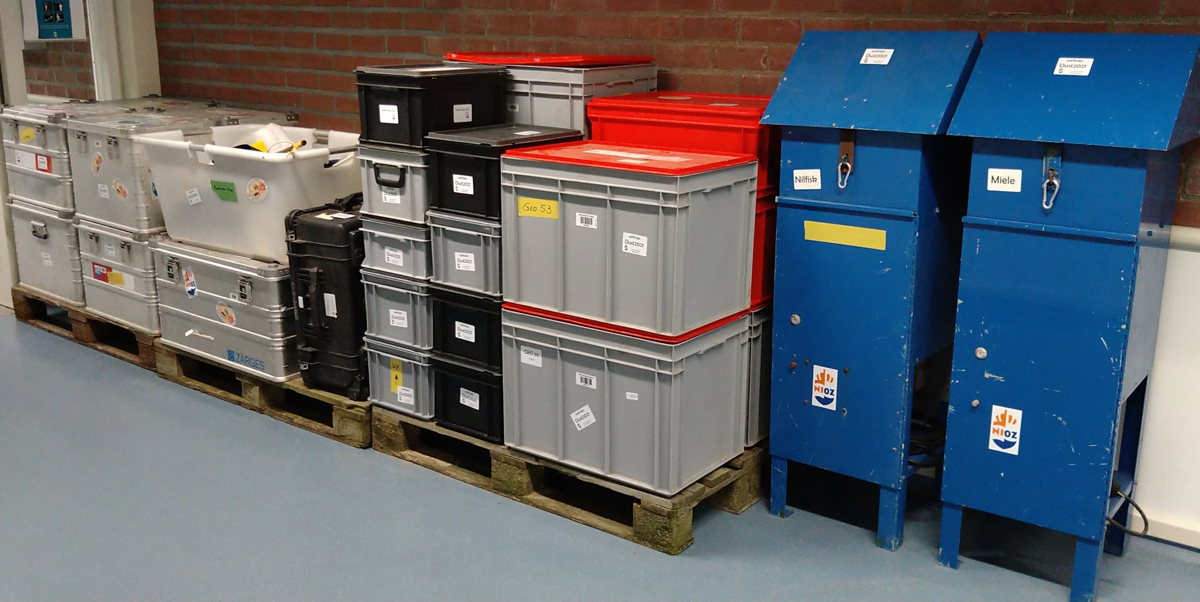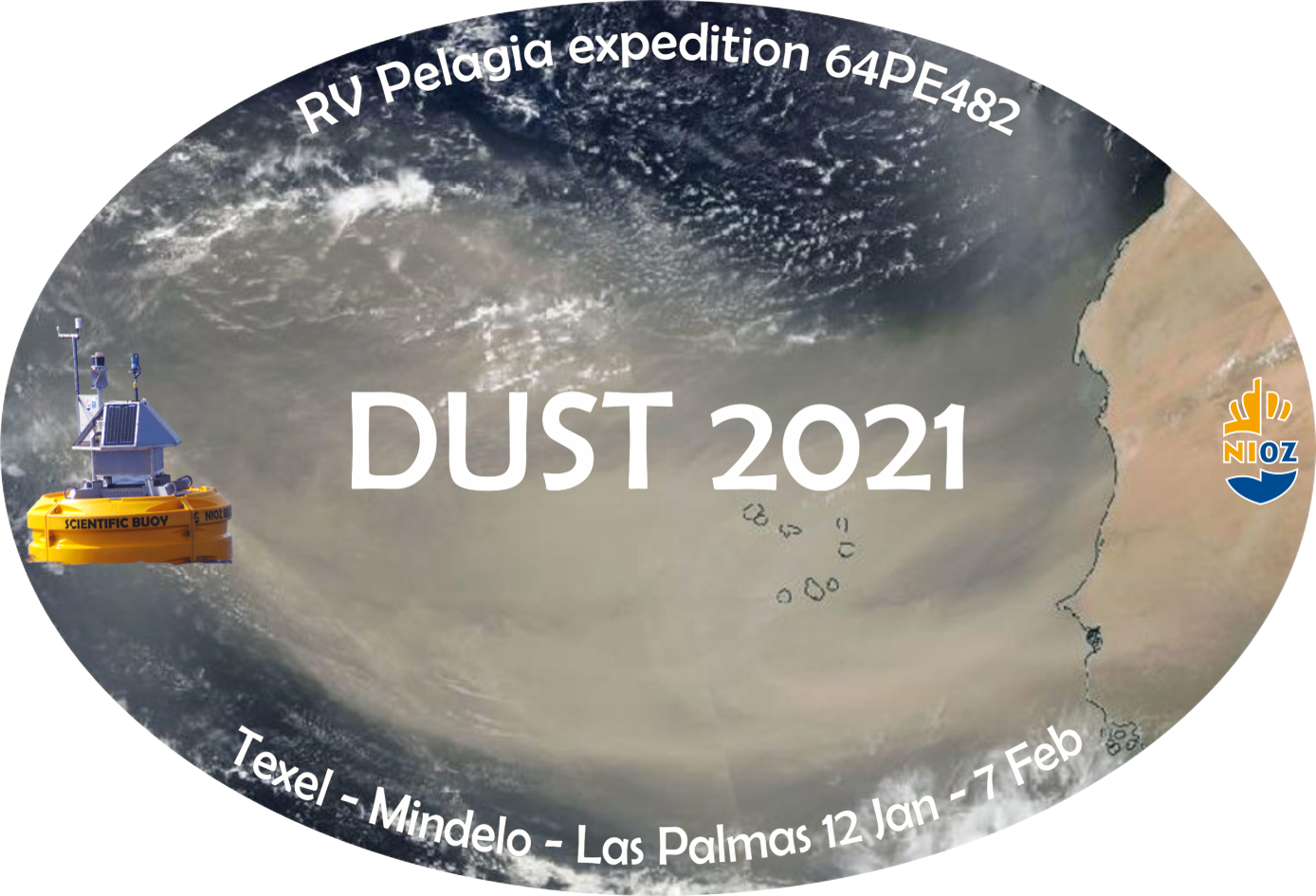
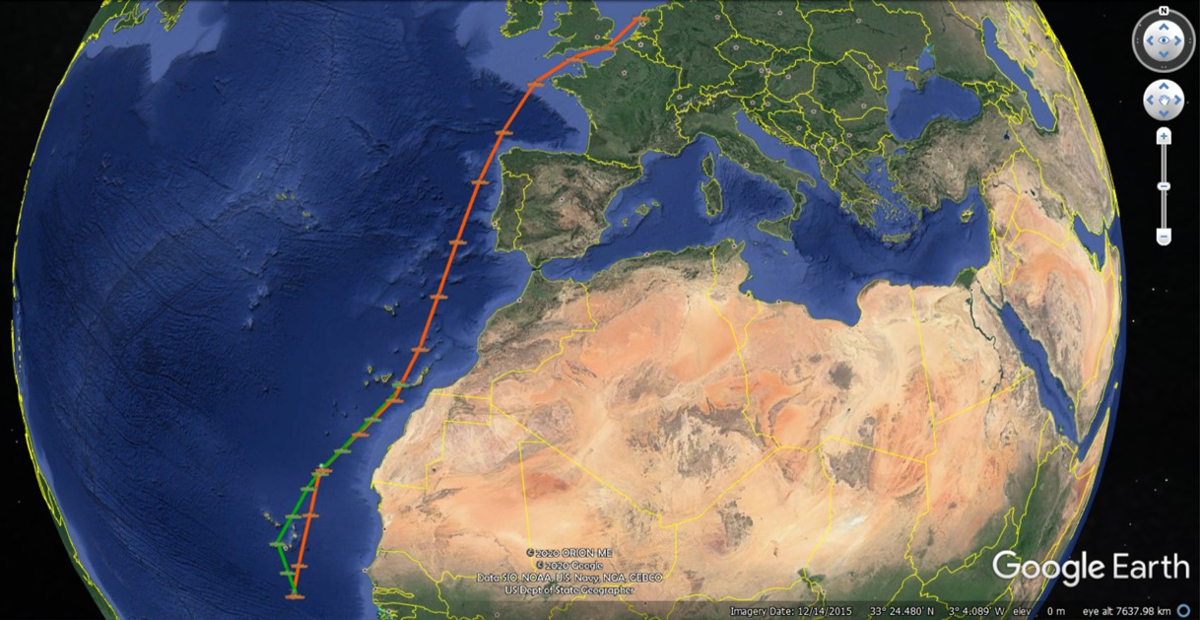
Regular updates below this point, most recent at the top:
6 February: Land ahoy!
In the afternoon of Saturday 6 February, we enter the port of Las Palmas on Gran Canaria, where our expedition ends, even one day earlier than initially planned. In these special times of a worldwide pandemic, we are very happy to have had the opportunity to do our work at sea.
We thank Master Len, his officers and crew, engineers Bert and Ian and Chef-steward duo Alex & Alex for taking such good care of us and look forward to the next voyage on RV Pelagia!
Finally, we thank you for following this blog. Please keep an eye on NIOZ' dustiest website www.nioz.nl/dust
#welstoffignietsaai
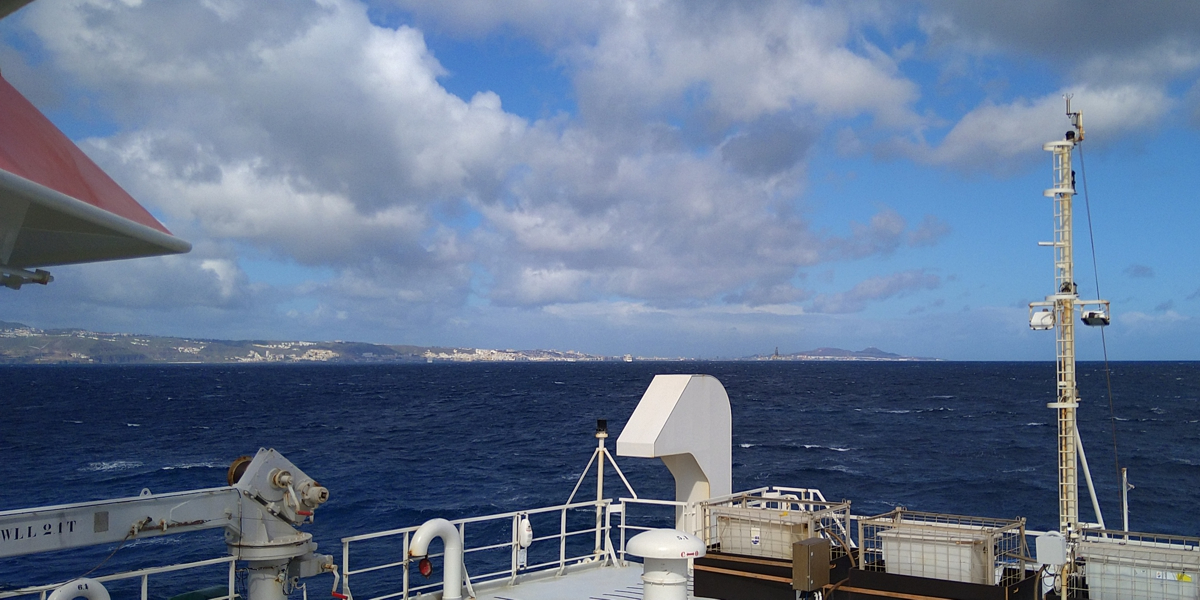
A short video of how we entered the port of Las Palmas on Gran Canaria, Spain.
6 February: the DUST2021 dreamteam
We conclude that this trip has been a really successful one! Despite some logistical and meteorological challenges all moorings have been recovered and re-deployed. A very nice set of samples has been 'harvested', both from the marine moorings as well as from the atmosphere. Now it is time to head towards Las Palmas on Gran Canaria (Spain).
On the photo, L2R: Barry, Len, Jolanda, Bert, Stephan, Alex, Ian, Roel, Jan-Dirk, Chiel, Martin, Alex, Bob, Peter and Jan-Berend
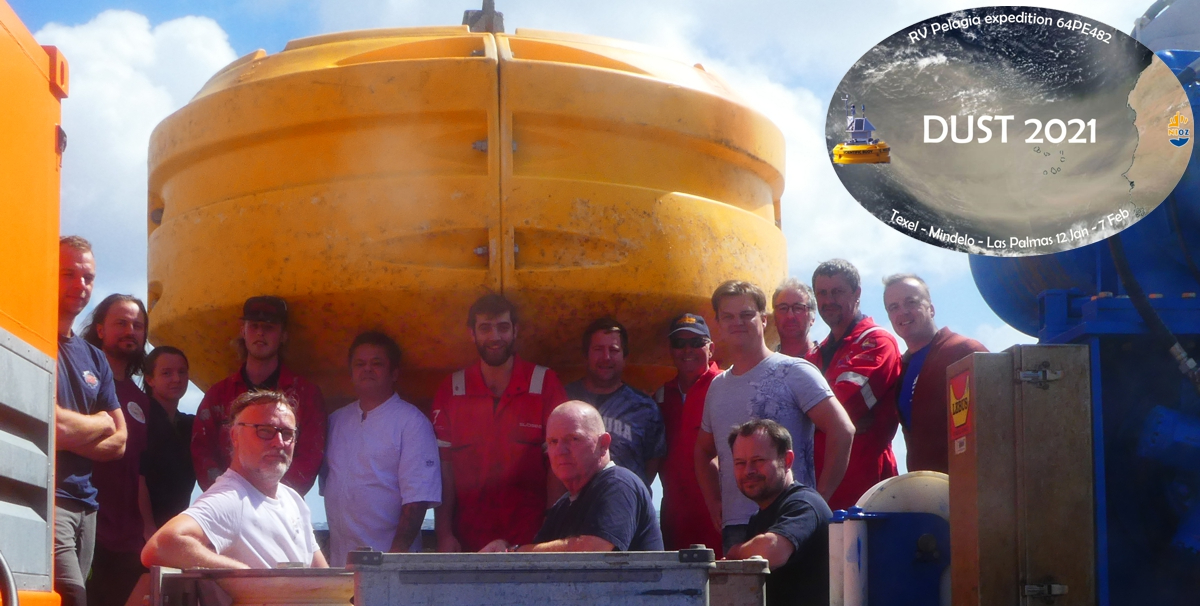
5 February: a successful deployment
After a full day of excellent teamwork between the NIOZ technicians and ship crew on deck and the officers on the bridge, buoy Carmen has been re-deployed successfully. She is floating happily again and collecting dust until we will service her again hopefully by the end of this year.
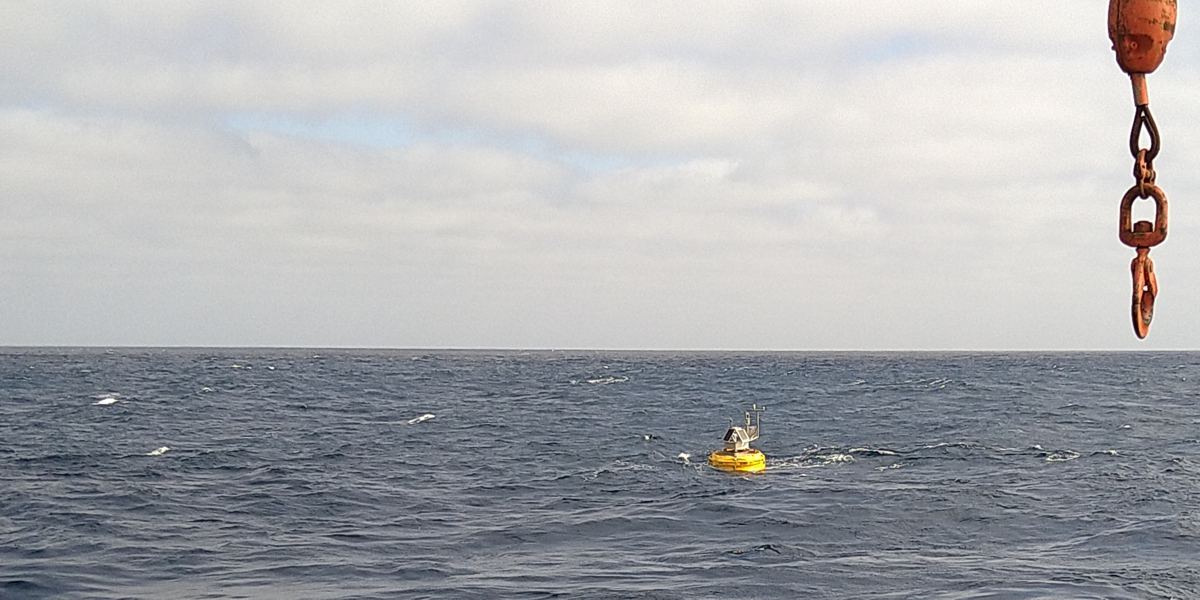
5 February: more visitors
In the area offshore Cape Blanc, Mauritania, there is a lot of wildlife to be seen thanks to the nutrient-rich waters that are upwelling here. In this video you see a group of pilot whales that checked us out while we were on station re-deploying buoy Carmen.
4 February: life on buoy Carmen
Once we have lifted buoy Carmen out of the water, we can see how the underwater parts are teeming with life.
The Atlantic Ocean offshore Cape Blanc, Mauritania, is characterised by upwelling of nutrient-rich cold waters, which lead to rich fishing grounds. Apparently, it also leads to huge amounts of gooseneck barnacles happily finding a place to settle on our buoy, as well as bivalves of up to 10cm in length. In addition, many small crabs wander across and feed on the algae and barnacles.
Another passenger we often see is the Alitta virens, or sandworm (Dutch: zeeduizendpoot), which also feeds on algae. These nasty-looking creatures are active hunters and can grow over 1m long.
The whole set of animals are part of the micro-eocsystem we often observe around the buoys including many kinds of fish like sharks and Mai-Mais.
3 February: no dust, no glory
In the region off Cape Blanc, Mauritania, which is normally characterised by large amounts of dust, these days there is little to be had. The sun is obscured by clouds, not dust.
Today we will re-deploy buoy Carmen and then head towards Las Palmas.
No reason to stay here when there is no dust.....
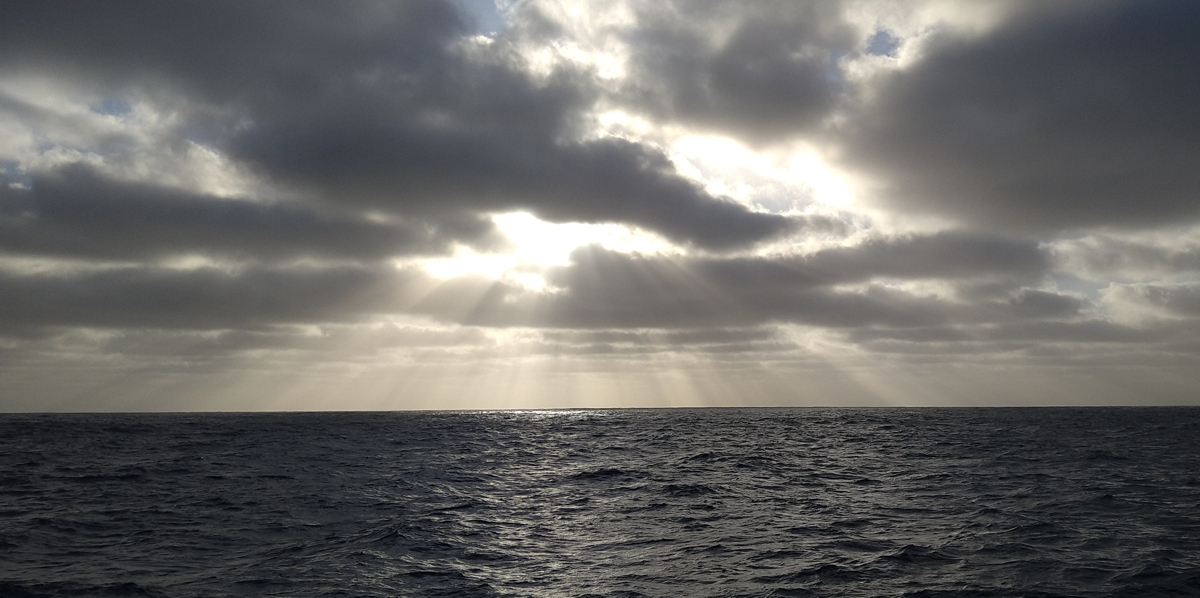
3 February: a dark recovery
Here you see a picture that was taken last night when we recovered the drifting traps just after dark. The traps had been drifting freely for some 20 hours and they have clearly resulted in much less material than the drifting traps we had deployed at the previous station. Our hypothesis is that this has to do with the amount of dust, which drags down material from the surface ocean to the deep. The skies are indeed clear at this station, confirming our hypothesis so far!
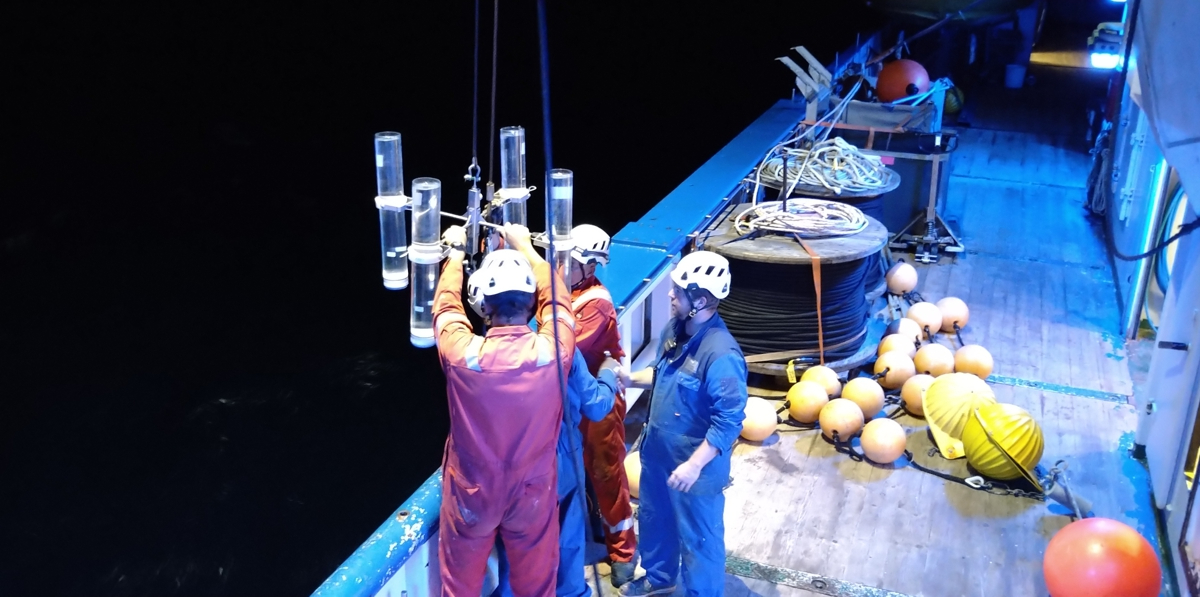
2 February: an unexpected visitor
Today is a busy day since we are recovering buoy Carmen and we are also making the preparations for her re-deployment tomorrow. Therefore, not an extensive blog but a nice little video instead of an unexpected visitor that came to check us out! #lovemyjob
1 February: Harvesting the drifting traps
The drifting traps have been floating around for some 30 hours and have collected material that was settling towards the ocean floor. After we recovered the traps, the tubes have been standing in the lab for some hours to allow the materal to settle to the "tube floors". This water is now ready to be filtered and the yield is quite surprising! The tubes have a diameter of about 10cm but still there is a lot of material, which we think is caused by the large amounts of dust that we see all around us.
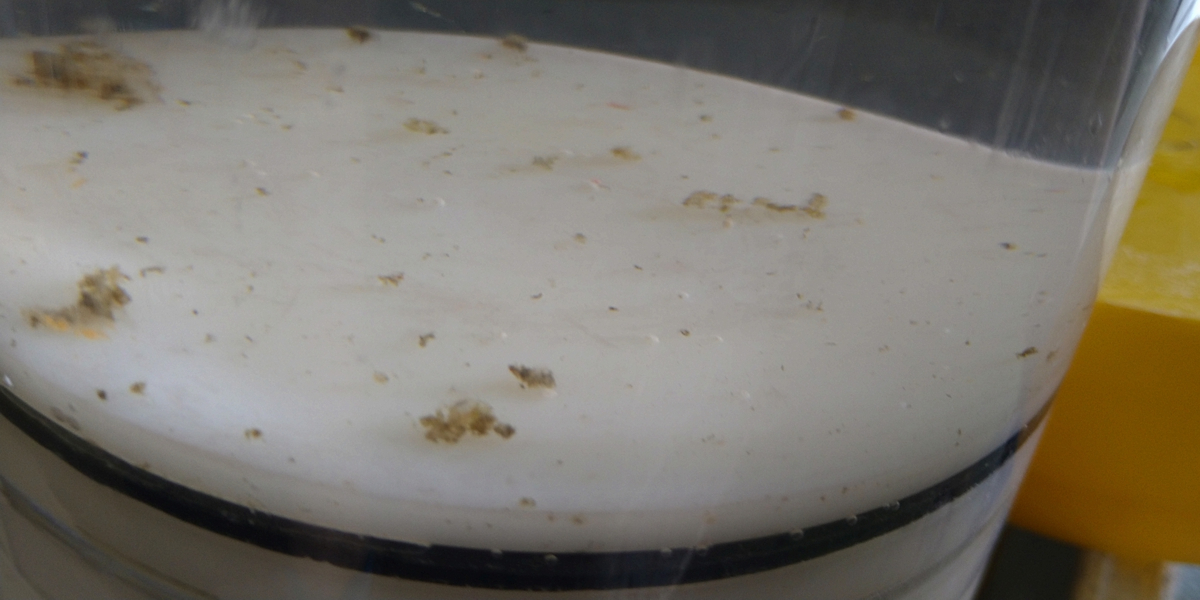
There is a clear difference betwen the three different depths; at the largest depth of 400m there was clearly less material present and the filtering process took way less time than at the shallowest depth of 100m.
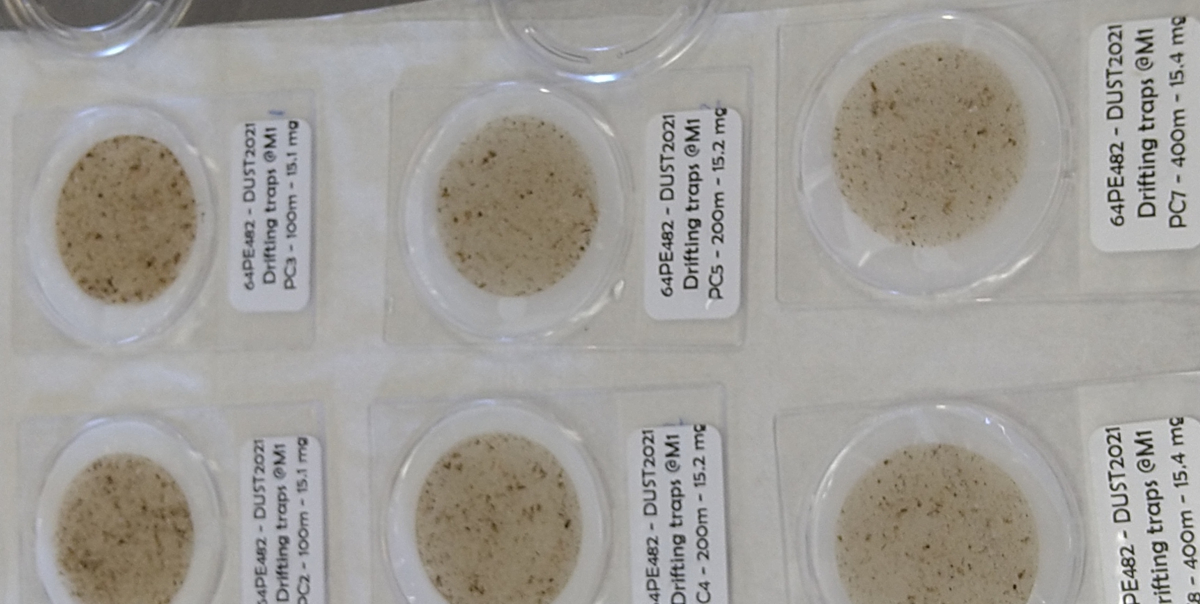
Just out of curiosity we put the filters under the microscope and saw --next to undefinite organic material-- all kinds of beautiful creatures. This is most likely a radiolarian, which is a protozoa of 0.1 - 0.2mm that builds a skeleton of silica.
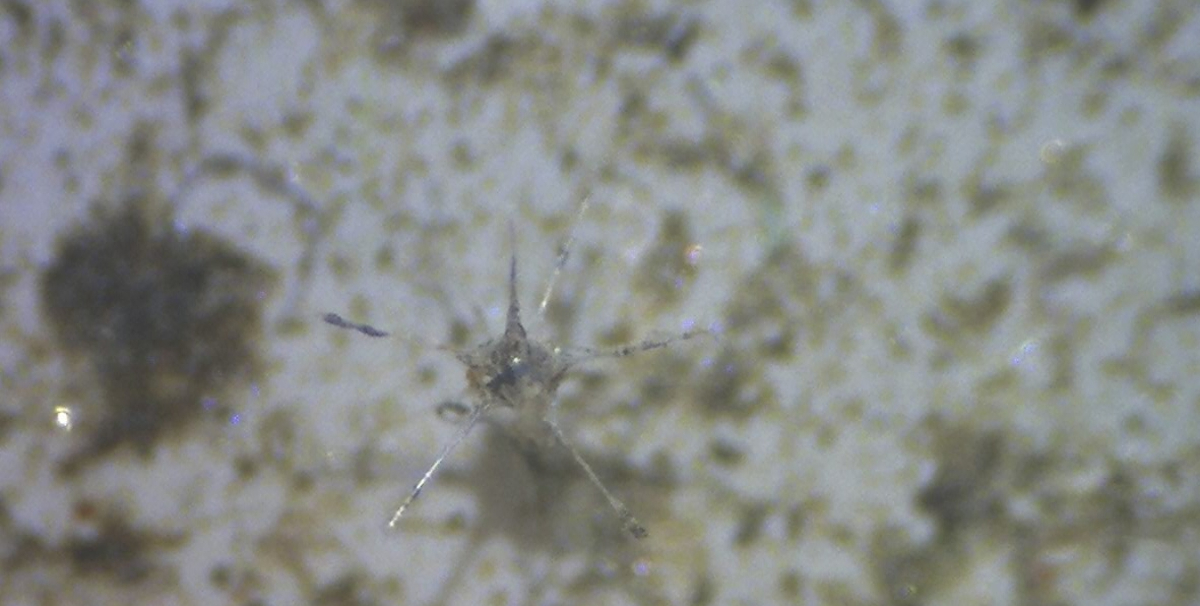
Here you see a few planktic foraminifera, unicellular organisms of up to 0.5mm that build a skeleton of calcium carbonate. They grow by adding new chambers, each new one a tick larger than the previous. The pink one is very easy to recognise; it is called Globigerinoides ruber pink.
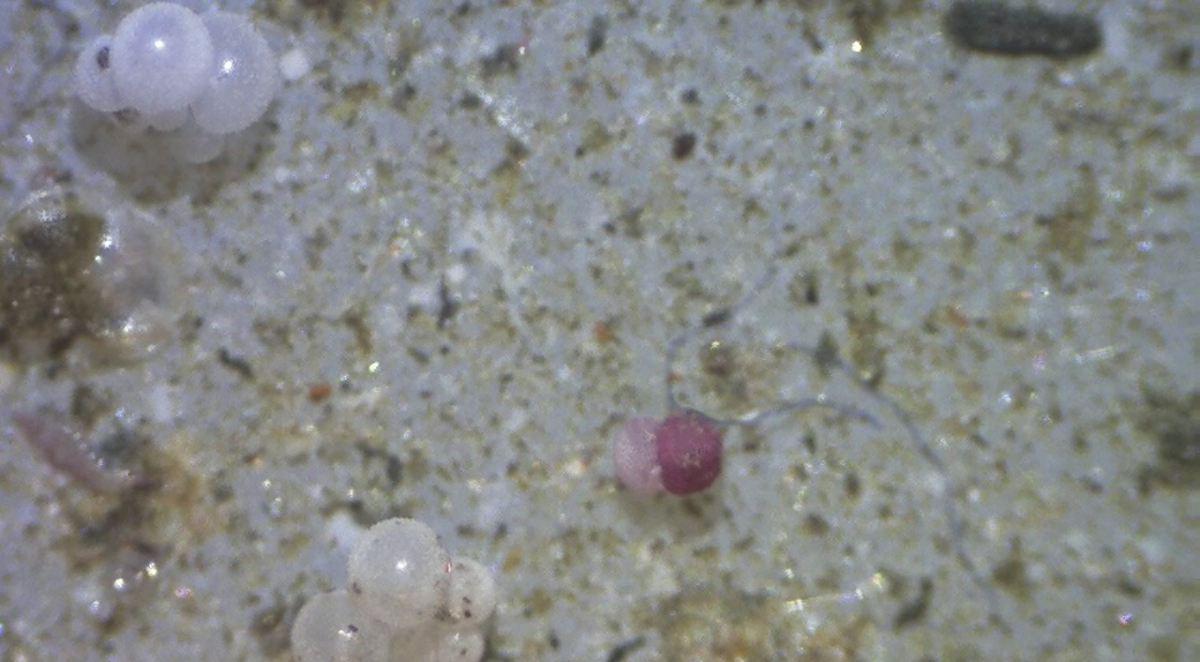
In basically all filters we find these foraminifera, here you see a few Globorotalia menardii, easily recognised by the keel on the outside of the chambers. In virtually all filters there are also fibers of plastic...
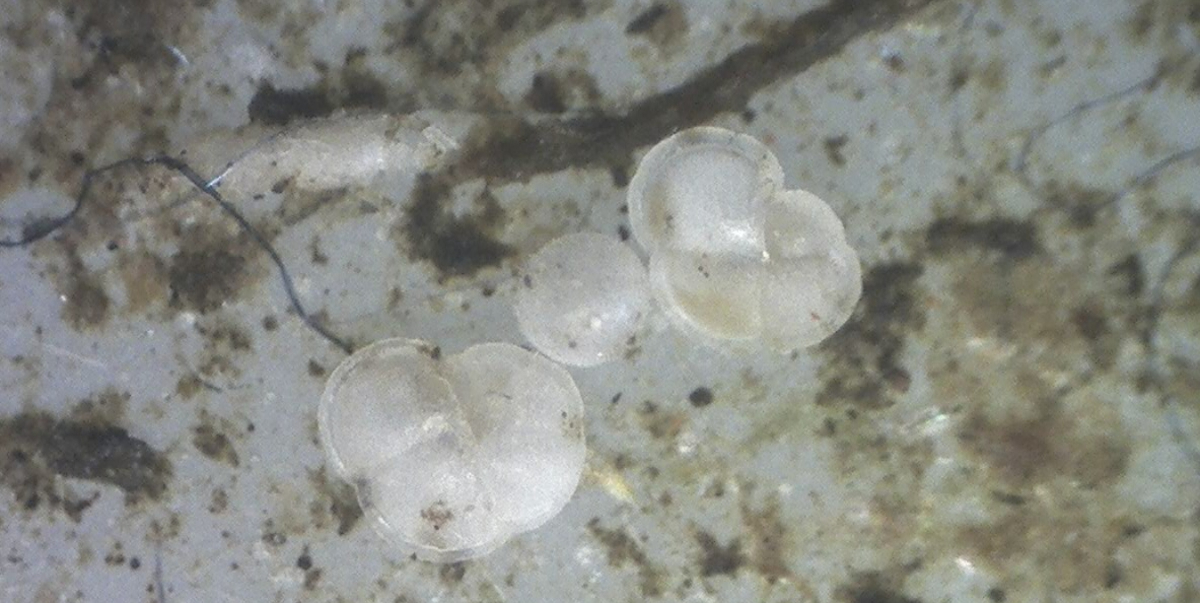
31 January: Video of re-deployment of buoy Laura
Here you see the final bit of a full day of concentrated work for NIOZ-NMF technicians Jan-Dirk and Barry, together with RV Pelagia's deck crew and the officers on the bridge. The deployment always starts with a dummy buoy, after which the whole mooring is layed out from top to bottom. Once the anchor has landed on the sea floor, more than 5km below us, the dummy buoy is replaced with the real one.
#welstoffignietsaai = dusty but not boring!
31 January: Video of recovery buoy Laura
Now that we are on a short transit, there was some time to edit some videos filmed during the recovery of buoy Laura. Here you see how from the lifeboat --manned by Pelagia AB's Chiel and Stephan and NIOZ-NMF technician Jan-Dirk-- two lines are brought to the buoy, attached to her and then brought back to the ship. Through the years we have learned that the lines should be attached such that the antenna is pointing away from the ship during hoisting, to minimize the risk of damage. Once both lines are attached, first the lifeboat is put back on board and then the hoisting starts. The sea state is nicely calm so that the buoy can be recovered safely.
Did you see the Mai-Mai jump out of the water? Now you know why they are also called "dolphin fish".
30 January: A good catch!
On the highest deck of RV Pelagia we installed two high-volume dust collectors, which pump air through A4-sized filters (see post of 18 January). Here you clearly see the orange-coloured dust on the filter, which is originally white; a good catch indeed!
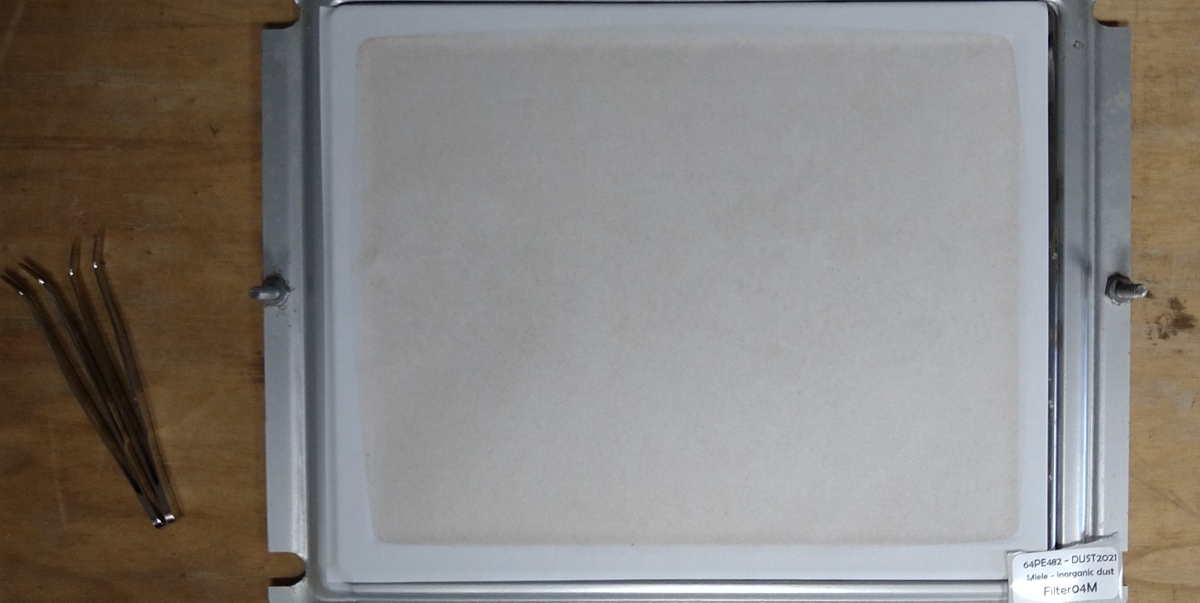
Also the Omni sampler (see 24 January's post) managed to collect dust; on the photo you see a blank cartridge and a dust-filled one; can you tell which is which?
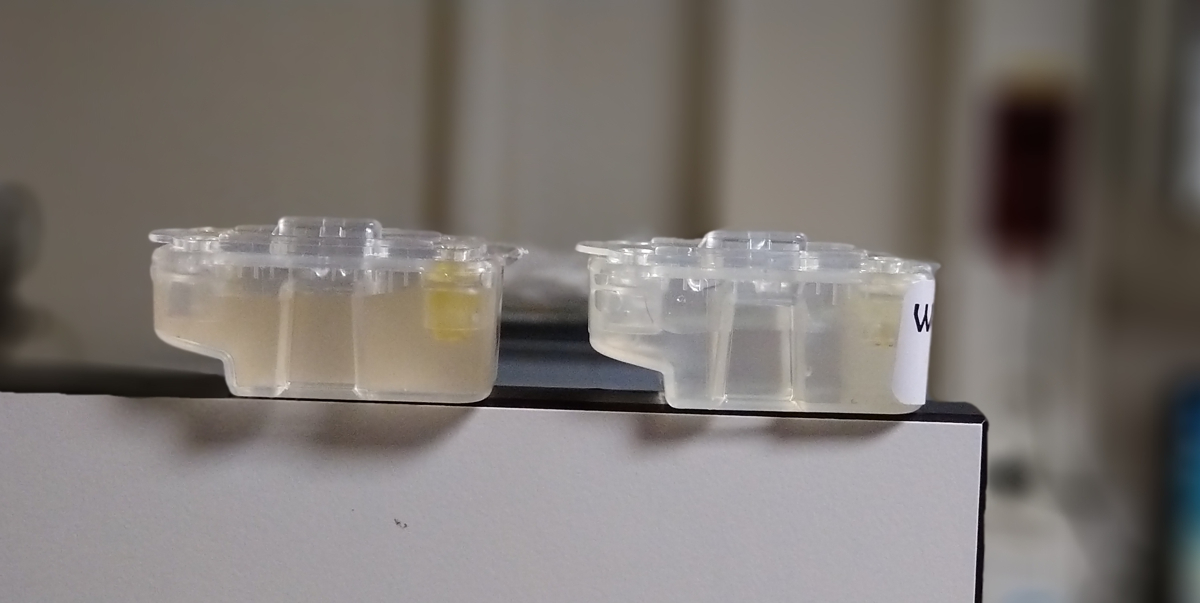
29 January: Drifting traps
To study the influence of dust particles on the downward transport of organic material, we use so-called drifting traps. These traps consist of transparent tubes that are hanging suspended in the water column. A gimbal makes sure the tubes are always oriented vertically and the open top allows particles to settle into the tubes. Our hypothesis is that dust particles drag down organic matter that would normally settle very slowly (or not at all). Our drifting traps consist of three sets of four tubes at depths of 100m, 200m and 400m that will be drifting freely for 24 hours. On the photo you see how bosun Roel handles the winch from which the traps are deployed. Jan Dirk, Stephan and Peter lend a hand in deploying the traps safely.
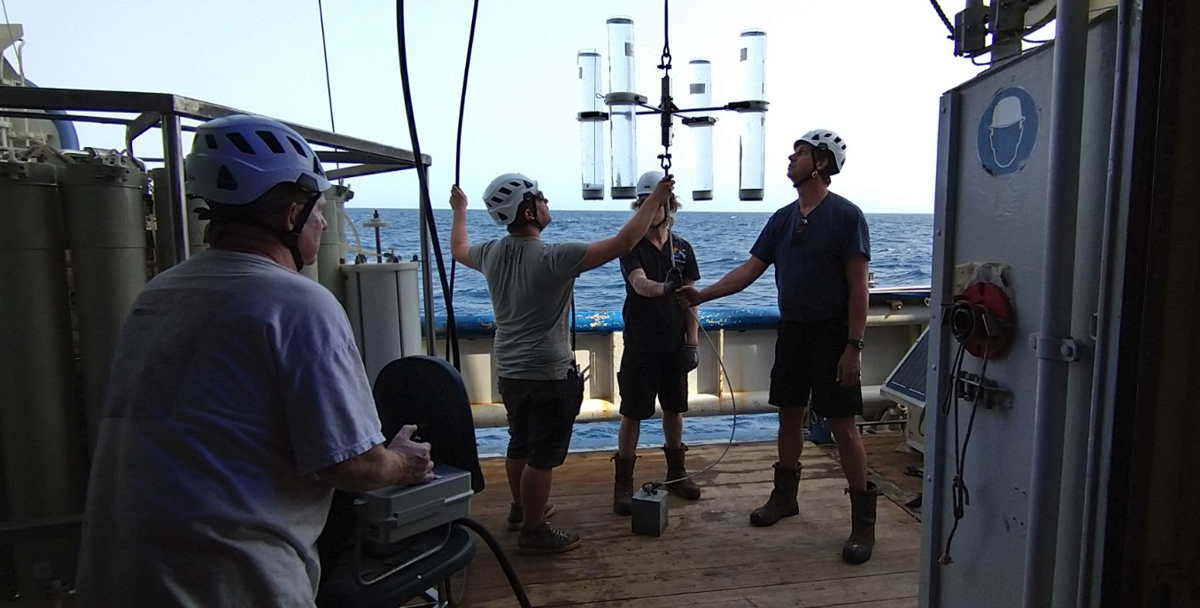
The drifting traps are really "on their own" for about 24 hours and to find them back we mounted a number of beacons on a float; a radio beacon, a flash light and a satellite beacon which sends an update on the traps' position every 15 minutes. Here you see a set of floats swimming in a neat row, followed by the orange buoy with the beacons and a long line with an additional float. The long line is meant to faciliate an easy pick up from the ship.
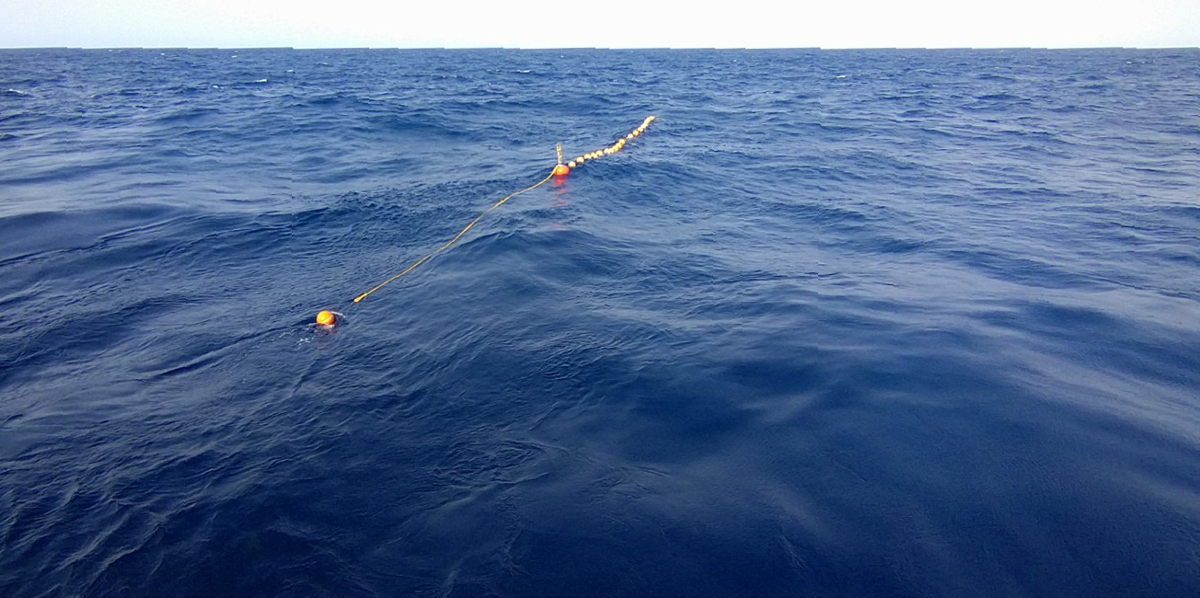
28 January: harvesting buoy Laura
Now that the buoy has been recovered and put safely on the deck of RV Pelagia, we are keen to see what she managed to collect in terms of meteorological data and dust. Here you see how NIOZ technician Bob Koster climbs into the dust-buoy's tower to open the box which contains the carrousel with all the filters. From the daily messages Laura has been sending us throughout the last year, we more-or-less know what to expect but we are obviously very keen to see with our own eyes what the yield is!
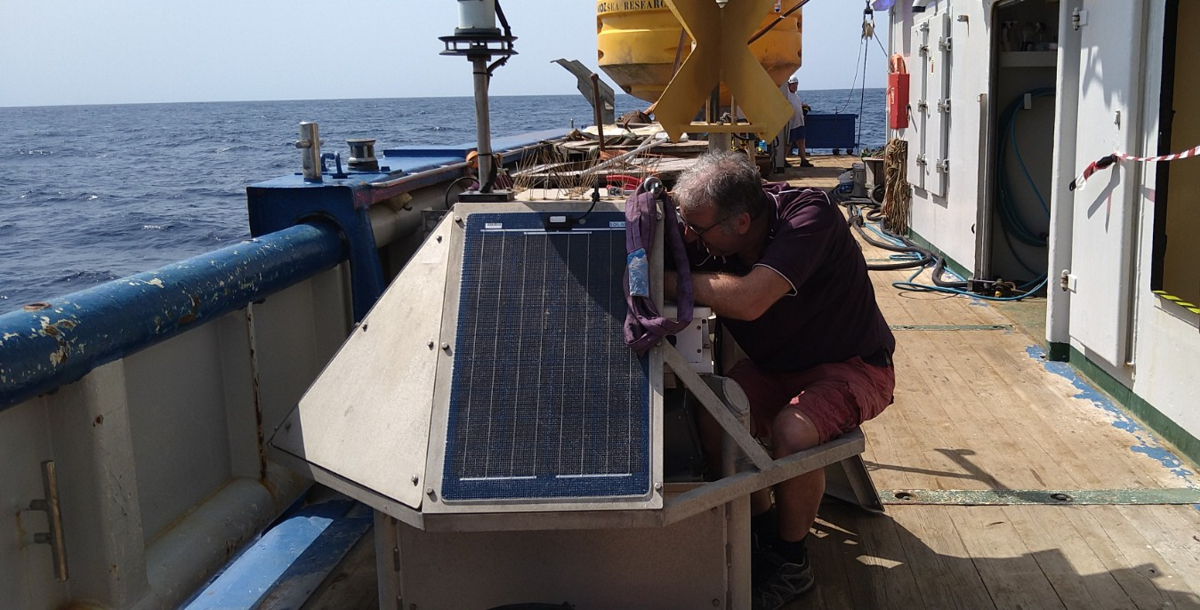
By connecting a pc to the buoy, we can learn what happened throughout the last year; the meteorological data are stored locally on a harddisk in much higher resolution than the two updates we receive daily per eMail. Also, we can rotate the filters one-by-one under the "exit", where we can retrieve the filter cups. Here you see how this particular filter is nicely coloured orange/brownish: Saharan dust! We know how much air was pumped through this filter and at home we establish how much dust this filter contains so in the end we can calculate dust concentrations, which help us calculate total mass balances of dust transport and deposition over the ocean.
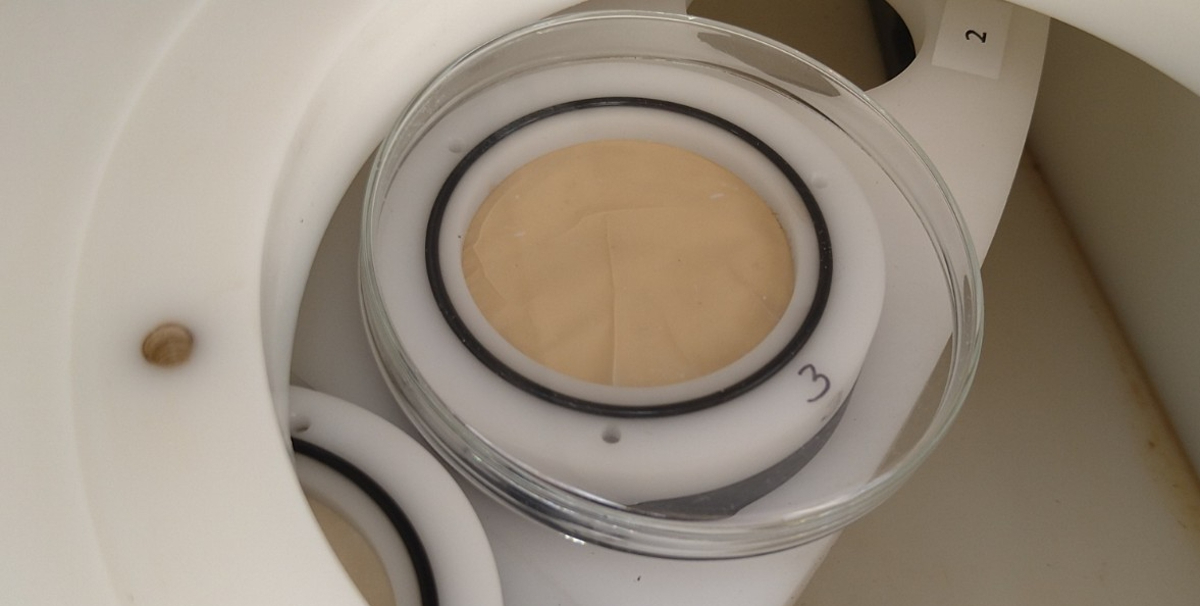
This poor bug(ger) took the challenge "eat my dust" a tick too seriously....
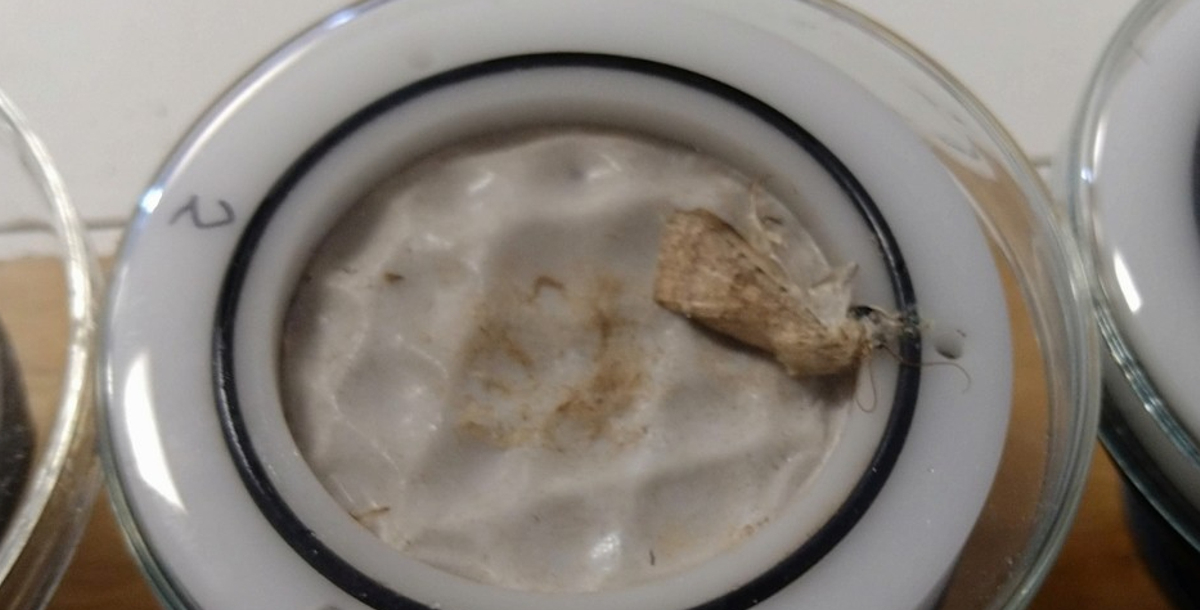
27 January: buoy recovery as seen from above
In this short drone video the process of recovering dust-buoy Laura is shown.
27 January: recovering buoy Laura
Today we intend to recover buoy Laura, who has been sampling dust since we deployed her in November 2019. It is always an exciting moment to find back an instrument like this and a challenge to actually get it on deck! Fortunately, the sea state allows the MOB boat to be used. A small team bings lines to the buoy, attaches them and carries them back to the ship. This way, the recovery can be controlled very well without damaging the buoy. NIOZ technicians Jan-Dirk and Barry work in close collaboration with bosun Roel and his team and the officers on the bridge.
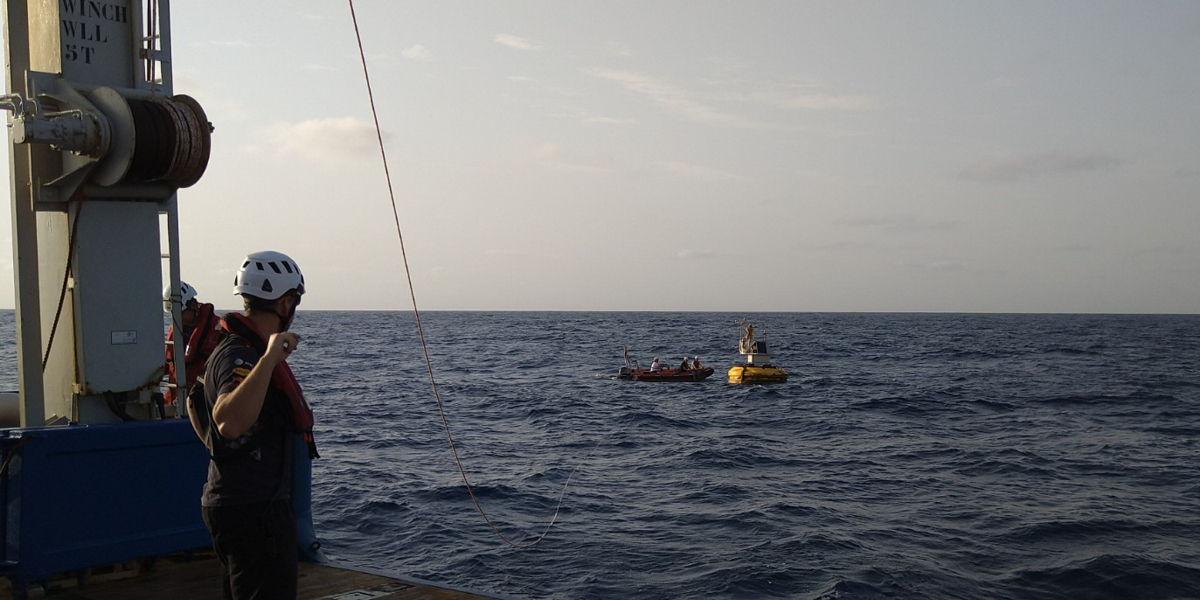
anticipation is in the air!
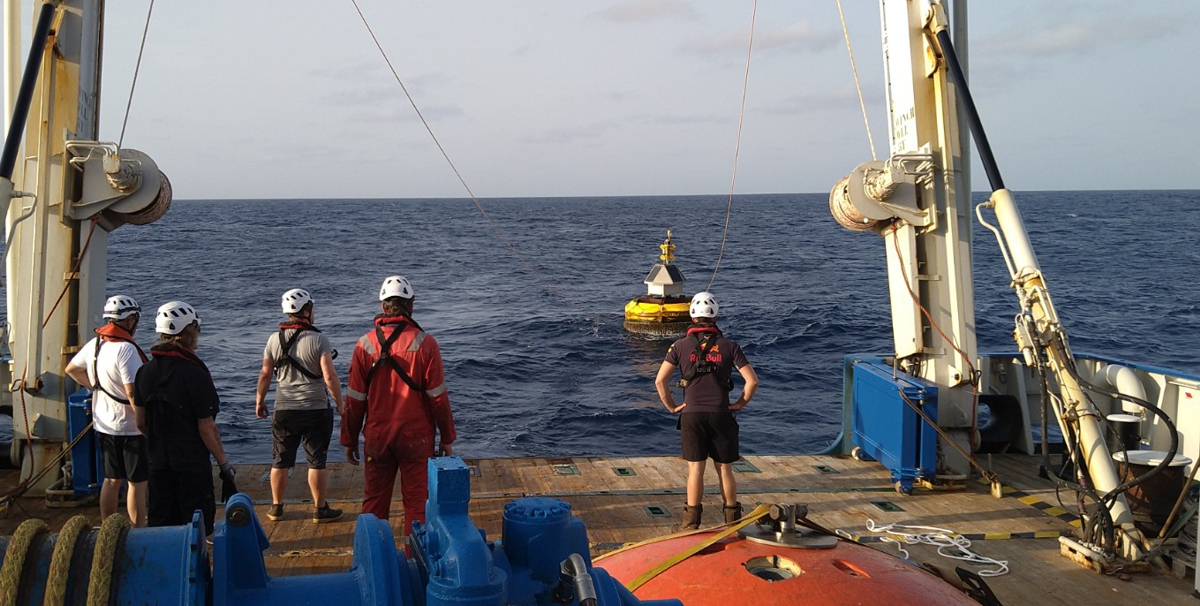
Buoy on deck!
Thanks to excellent teamwork the buoy is now safely secured to the deck. Bosun Roel has the best view from the little hut from which the A-frame and winches can be operated.
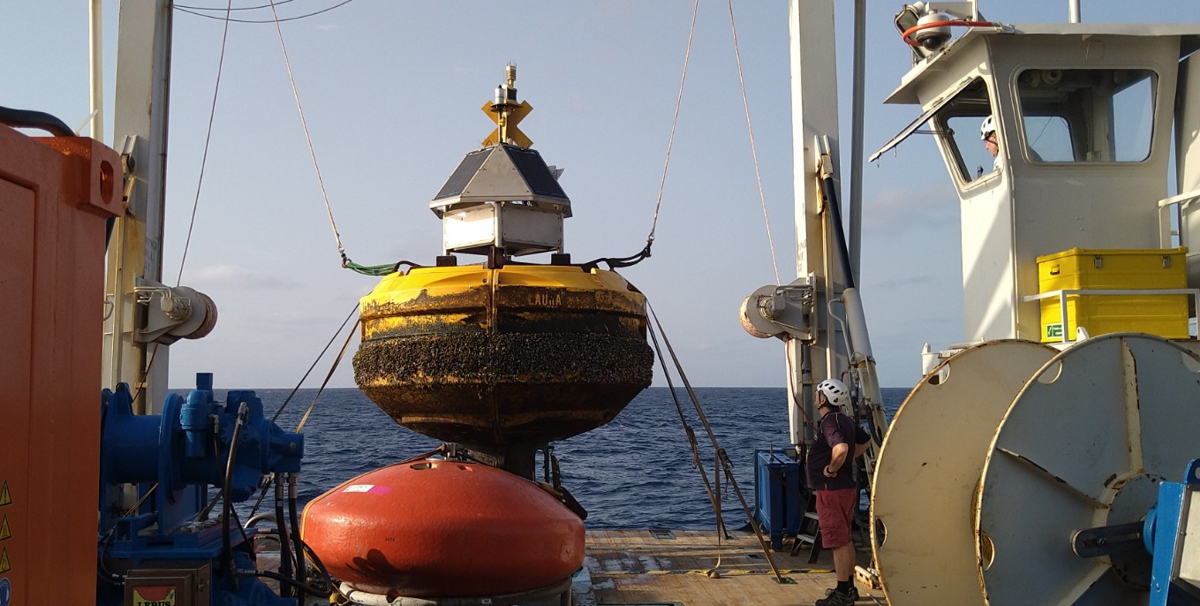
26 January: never too busy for a nice sunset
Today was a very busy day so there was no time to post something on this blog. We were not too busy to enjoy a beautiful sunset.....
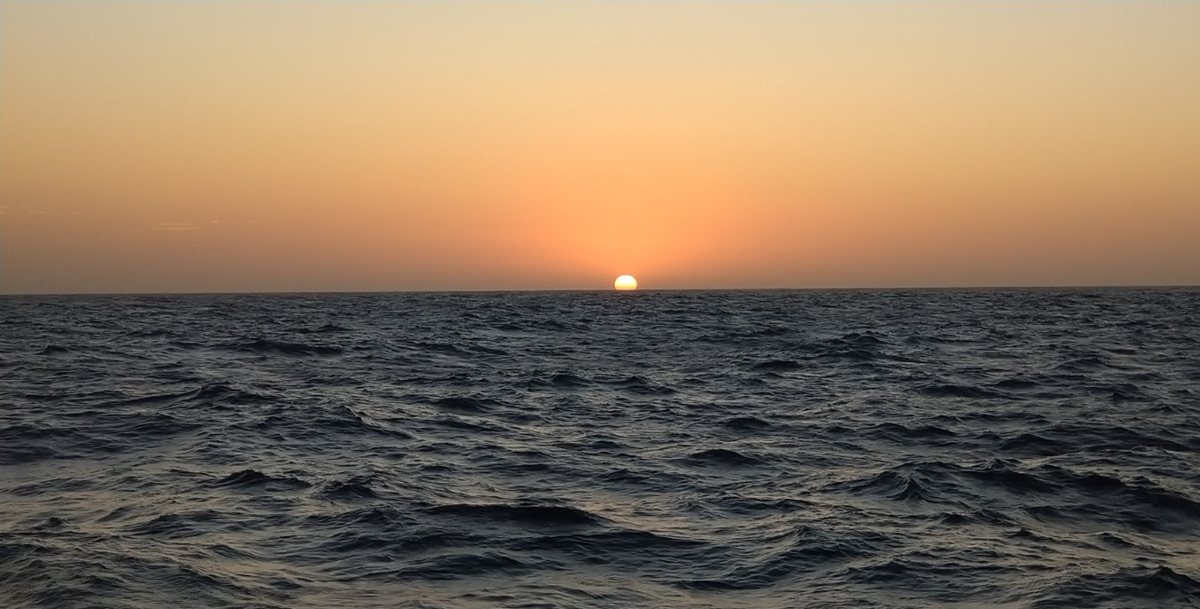
25 January: Sargassum
In the Sargasso Sea, there is a special type of macroalgae (seaweed) called Sargassum. These plants are free floating and mostly occur in the western part of the Atlantic Ocean. As these algae are potentially a way to mitigate climate change (they photosynthesis, so they sequester CO2 from the atmosphere) and since they also tend to cause problems on many Caribbean beaches where they wash up in large smelly numbers, they are studied by a number of NIOZ colleagues. These seaweeds do not usually occur in the eastern part of the Atlantic but here we are seeing them in small patches lined up by the wind.
For scale: each string of Sargassum is about 2-3m long.
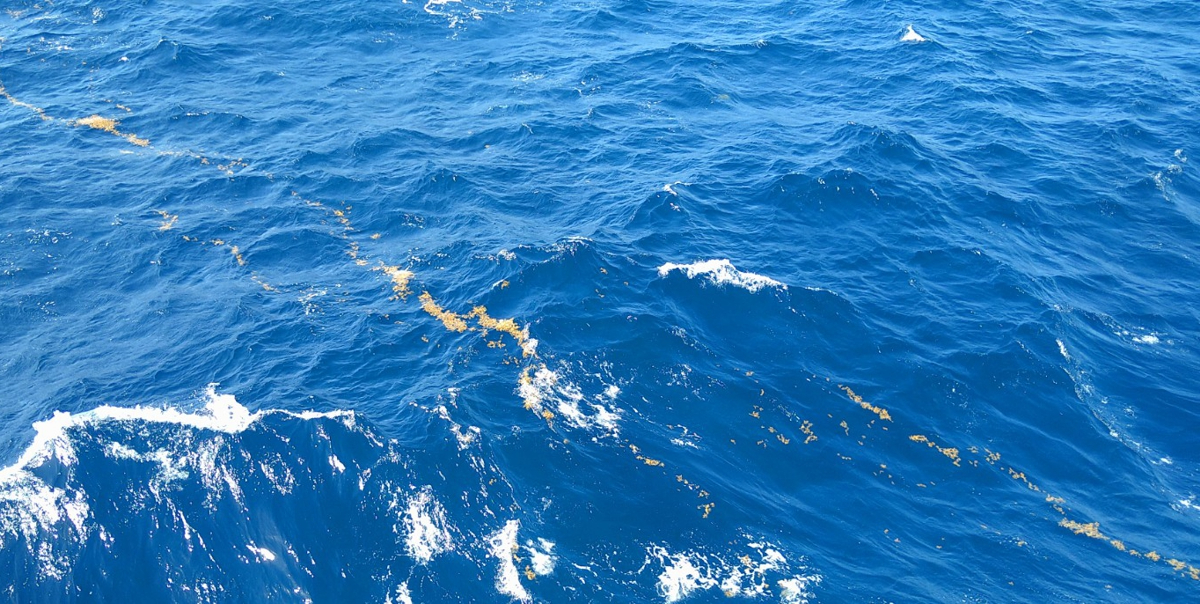
We stopped a few times to collect Sargassum for our colleagues at NIOZ. These few patches of plants are full of life; they contain little crabs and large number of tiny shrimps.
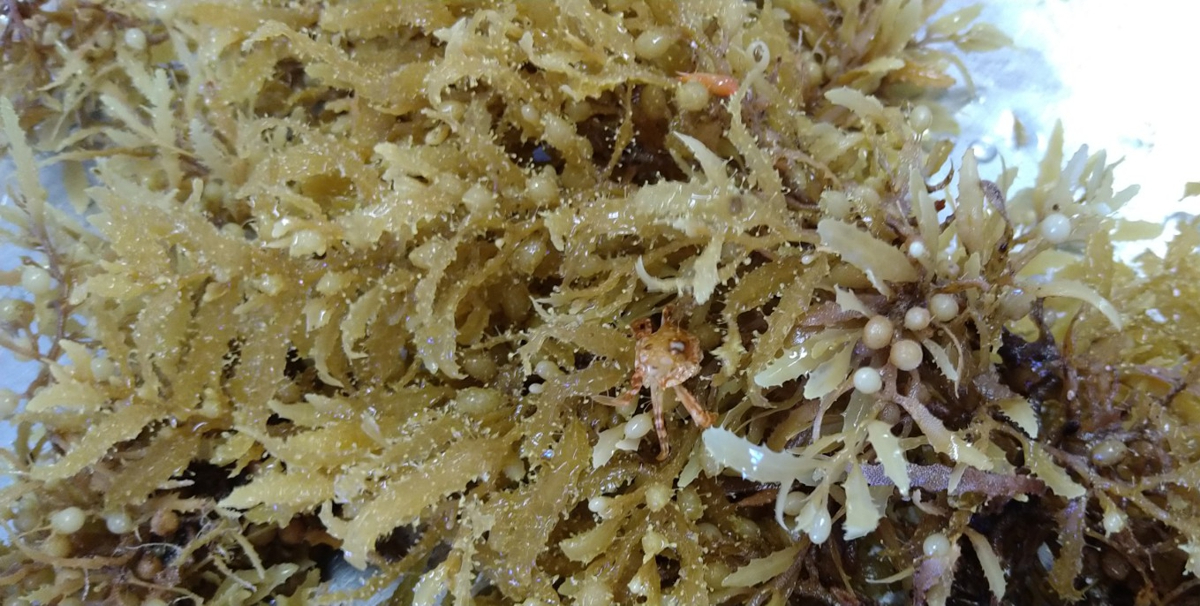
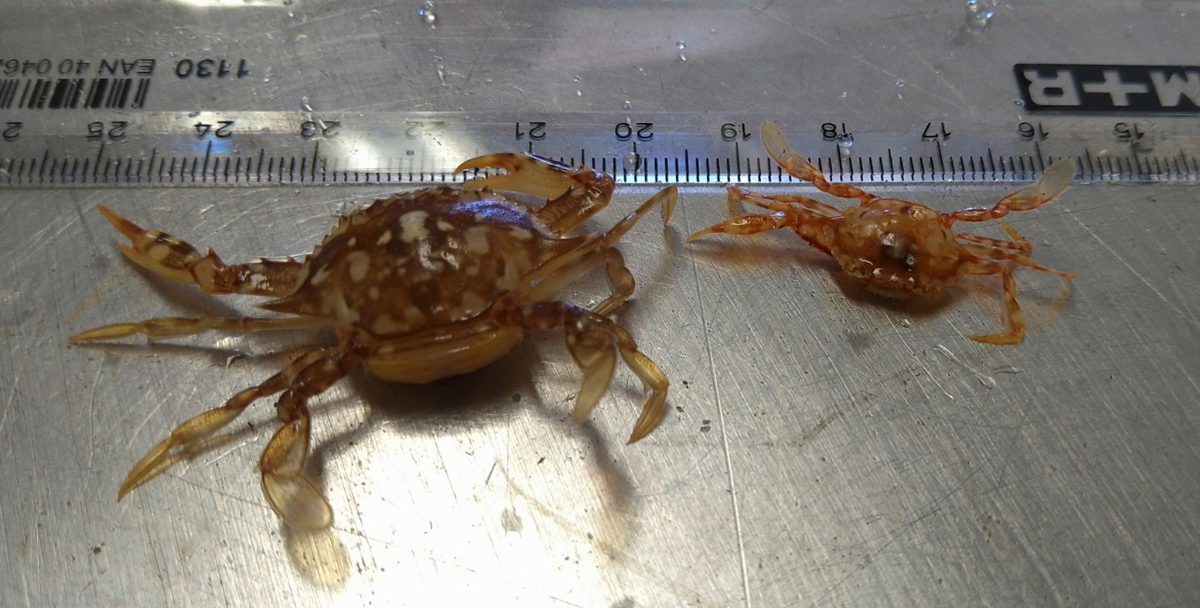
24 January: Dust is in the air²
As we could clearly see in the Windy.com-animations, there is a lot of dust in the air in the area we are sailing through. This dust is seen as a kind of haze and can be best seen when the sun is low. At the moment, our course is south and as the wind is from the north, it passes over the ship before reaching the dust collectors on the bridge. As a result, they are not switched on. Once we are on the return towards the north we will have ample opportunity to sample dust again with these two high-volume collectors.
Another way to tell that the winds are carrying dust from the African continent is the amount of insects that land on the ship. These poor bugs were blown from their homes towards the open ocean and are happy to land on our ship.
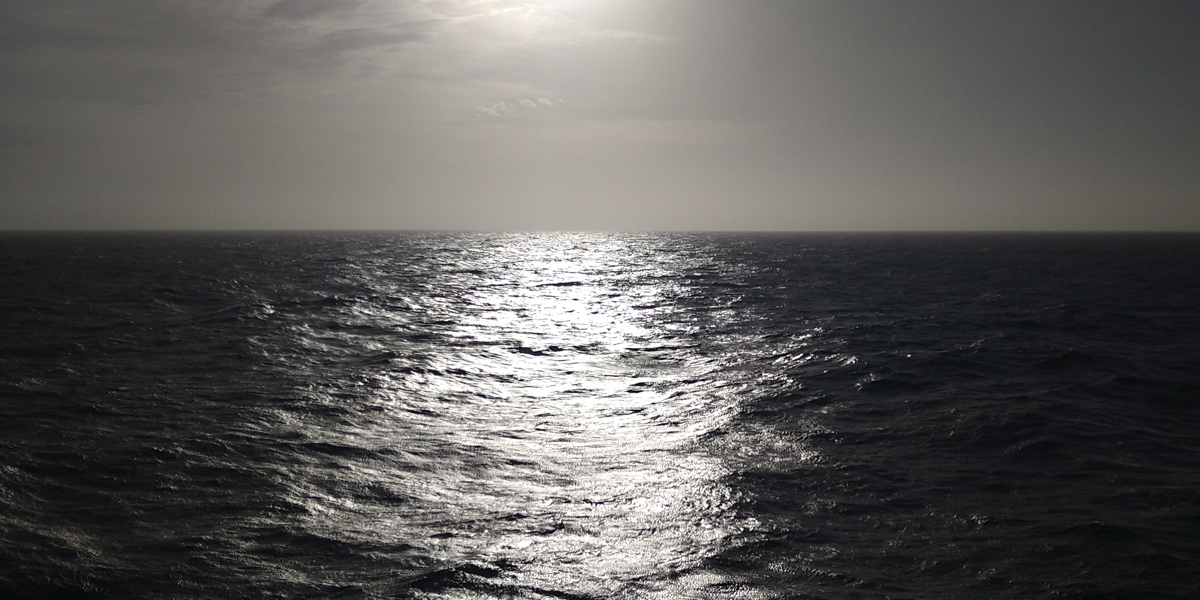
24 January: Yet another dust collector
Next to the high-volume dust collectors, which are permanently mounted on the top deck of RV Pelagia, we have yet another device to collect dust. This piece of equipment is a little more flexible and due to the ship's course and relative wind direction, we placed it on the aft so that there is no risk of any contamination.
This machine, an OMNI 3000, pumps air into a chamber with sterile water, in which the dust particles and all its microbiological components are preserved very well. On the right of the machine you can see the grey hose through which an air stream is led into the transparent chamber in which water is centrifuged. After a period of four hours, the collected material is transferred to the transparent cartridge in the lower middle of the machine. This cartridge is then removed, labelled and stored at -80oC to stop all biological activity. Once at home, the material will be studied for DNA of microbes travelling with the dust particles.
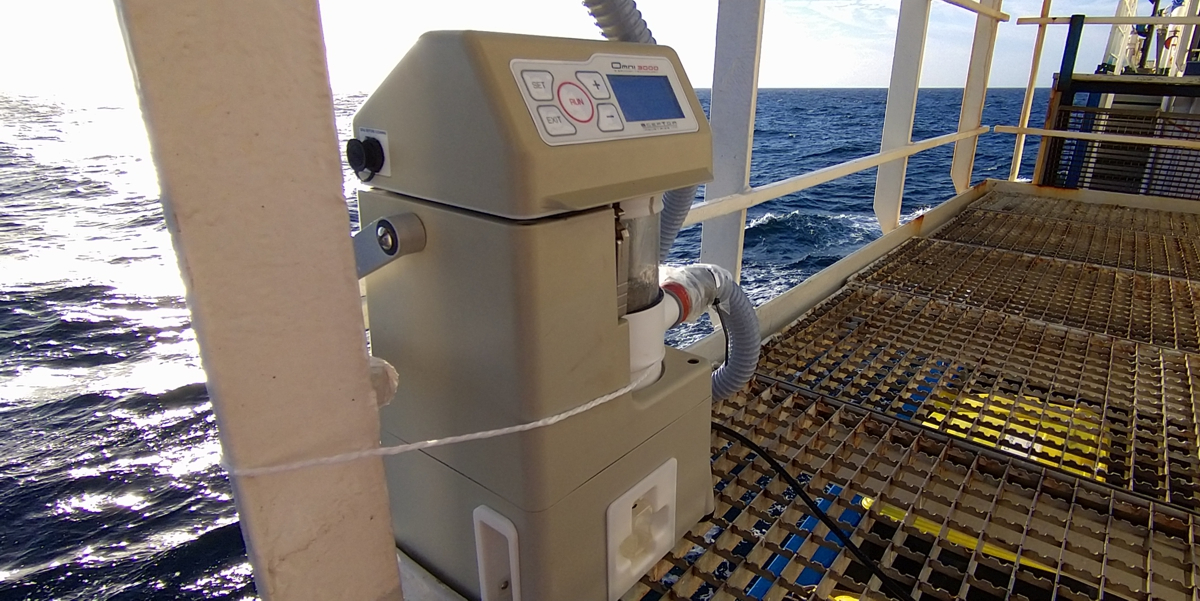
23 January: Dust-collecting buoy Carmen
The pride-and-joy of this project is the pieces of equipment that were produced at NIOZ (in close collaboration with colleagues from MARUM-Bremen and after the pioneering work of prof Ed Sholkovitz at WHOI): the dust-collecting buoys which we are now using to monitor Saharan dust at sea. At the moment there are two of these buoys: Carmen and Laura, named after former PhD students in the project who graduated already years ago. The third buoy -Michelle- is back at NIOZ at the moment. The last time we have deployed Carmen was during expedition 64PE464 in November 2019 and she has been collecting both meteorological data as well as dust. One of the major events we are hoping to find back on the filters is the giant dust outbreak that occurred in June 2020, named Godzilla. As you cansee on the video, the 3-m diameter buoys are just tiny specks on the vast ocean!
22 January: Dust is in the air
Just as the webtool www.windy.com can forecast the sea state (see the post on 17/1), it can also show the amount of dust in the air. Below you see a video, which is a compilation of three-hourly images of the amount of dust in northwestern Africa and over the eastern equatorial North Atlantic. The darker the brown colours, the more desert dust is in the air, a scale bar is in the lower right corner. One can clearly distinguish the Bodélé Depression in Chad, which is presently the largest dust soucre in the world. Every image also has the actual position of our ship and you can see very well that we are approaching the dusty part of the Atlantic Ocean, where our instruments are monitoring Saharan dust. Tomorrow we expect to reach the position of buoy Carmen, which we hope recover and re-deploy in the coming days.
22 January: Foam-cup experiment
Yesterday, when we did the CTD deployment to 3000m, we also carried out a small experiment. On yesterday's photo you can see a pink object attached to the CTD frame. Inside this laundry bag, there were a couple of styrofoam cups. Styrofoam contains a lot of air, which is squeezed out when put under pressure.
When diving into the ocean, it not only gets pitch dark and cold, the pressure also increases tremendously. With every 10m of water depth, the pressure increases with 1 bar. So, at 3000m, the pressure is 300bar!! This will easily press out all the air from the styrofoam cups, and that is exactly what we have observed. On the pictures below, you can see how the cups have shrunk and -unfortunately- deformed a little bit.
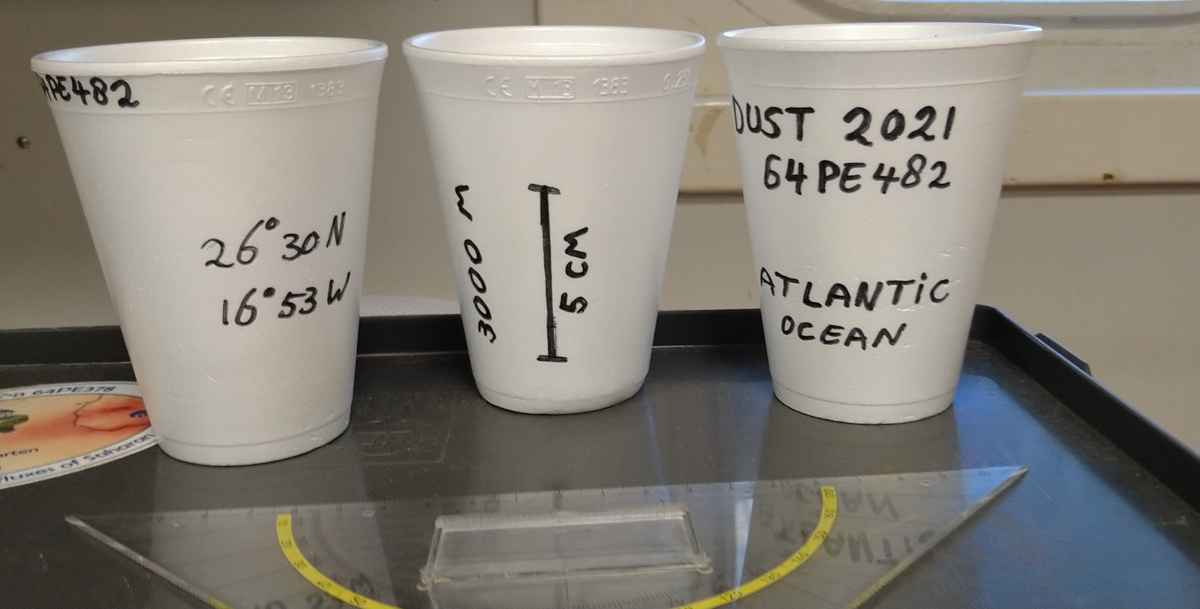
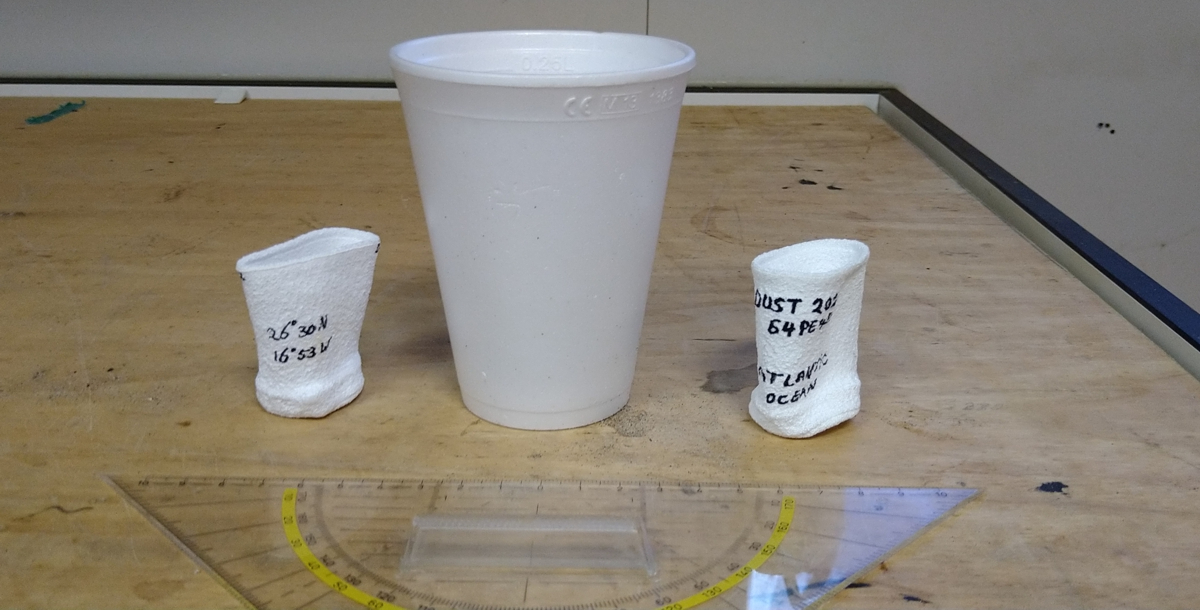
21 January: Our first deployment
Big excitement today: we were going to deploy the first instrument of this expedition!
One of the vessel-mounted instruments is a so-called multibeam or multi-echo-sounder. Multiple beams of sound are sent from the ship towards the sea floor, where they are reflected back to the ship. This way, with a single beam we can see (actually: hear!) how far the ocean floor is, some 3-5 km below the ship. With multiple beams we can even scan a portion of the sea floor. With the combined interpretation of all these beams we can create a bathymetric map.
The sound waves travel through the water at a speed of about 1500m/s. However, the sound velocity through water obviously depends on the density of the water, which is not homogeneous and which is related to temperature and salinity. These latter two: T and S are measured with sensors that are mounted on the piece of equipment that you see here. This is a so-called CTD rosette with N=24 20-liter water bottles. The idea is that one lowers this CTD through the water and on the way down, different sensors provide online information on the ocean-water properties. The water bottles are open when the CTD is lowered to the sea floor and when it is hoisted up again, we can close them one by one at the desired depths.
In this case we did not sample any water, we only wanted to have good T and S data so that we can produce detailed and accurate bathymetric maps.
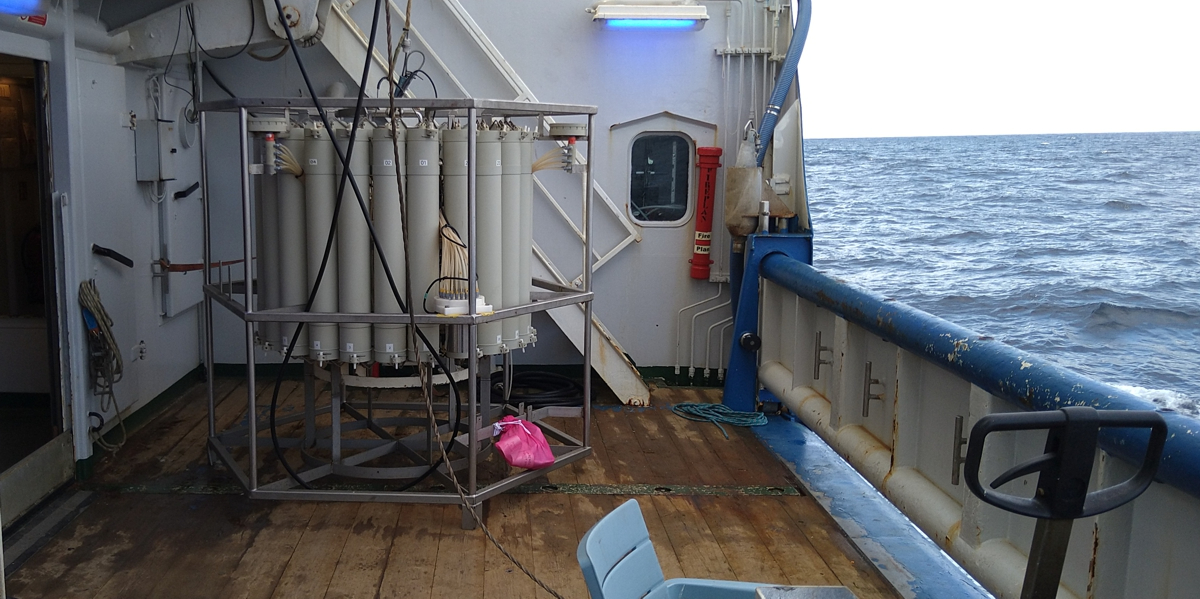
Here you can clearly see how all the bottles are open. Also you can see how the bottles are lined up in an outer ring, the inner ring is where all the sensors are. The data that these sensors acquire are sent to the ship through the cable from which the rosette is hanging. The bottles can be closed from the ship through a command that is sent through that same cable down to the rosette. Unfortunately, one of the bottles malfunctioned so Bob had to inspect it and fix the problem.
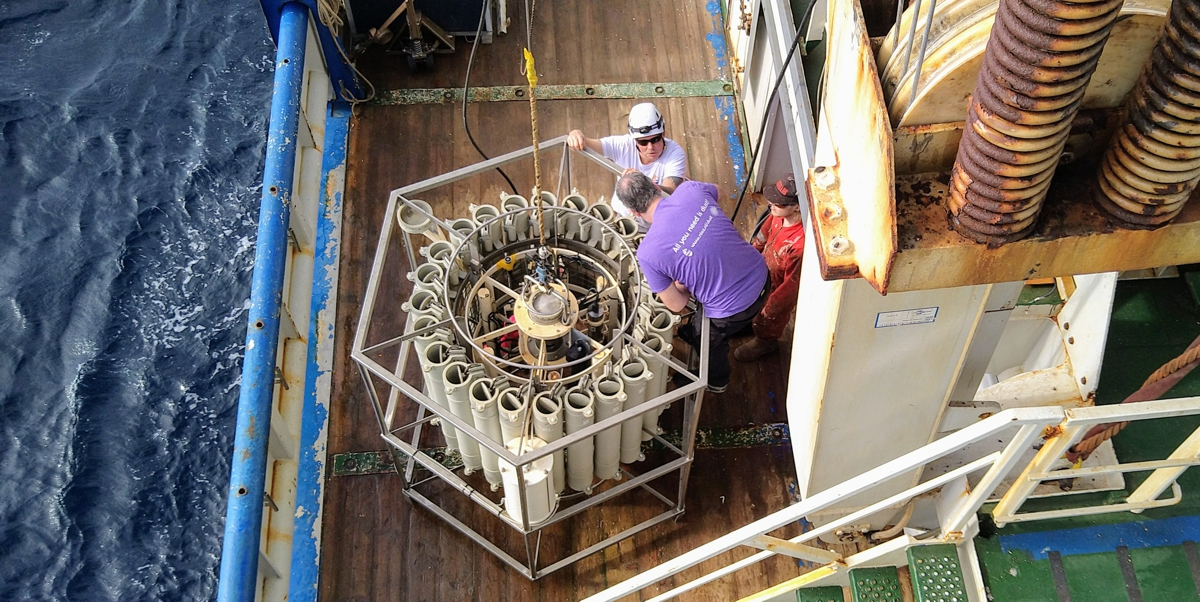
21 January: Las Palmas by night
During the night we passed through the waters between the Canary Islands of Fuerteventura and Gran Canaria. The moonlit strait between the islands is pretty narrow so we could see the lights of the harbour of Las Palmas on Gran Canaria.
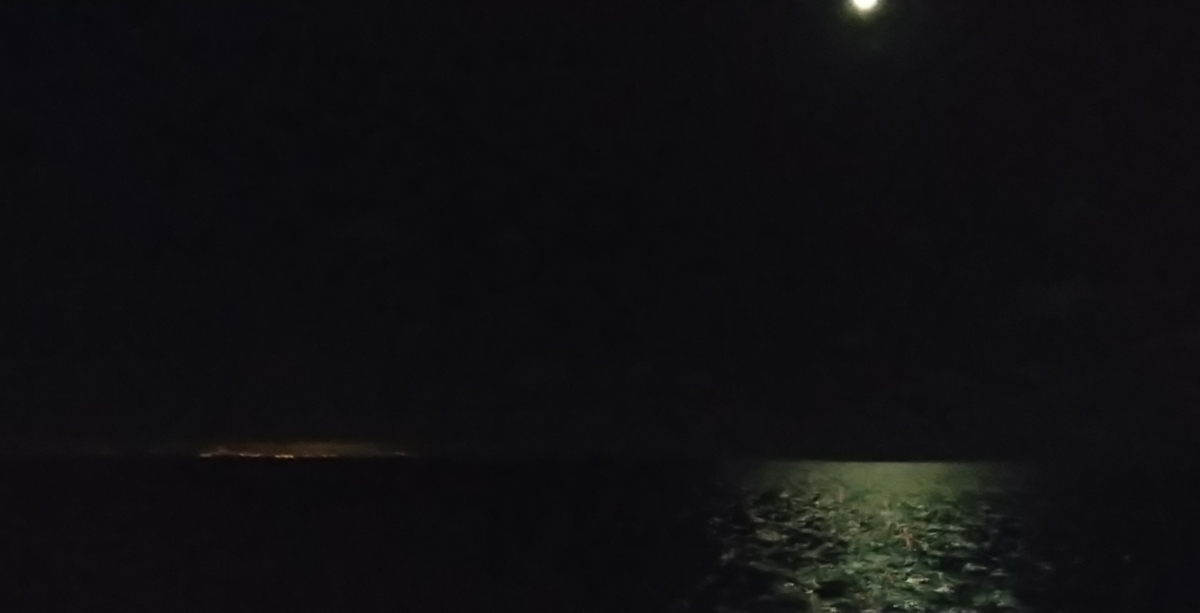
20 January: Toolbox meeting
As we are approaching the first station --well; it is still more than two days sailing from here on-- we want to prepare for what's coming. Together with NIOZ technicians, officers and deck crew we discuss the job at hand: recovering buoy Carmen and deploying her again. During previous expeditions these operations were filmed in a time-lapse movie so that we can illustrate each and every step in the procedure on the big screen in RV Pelagia's lounge.
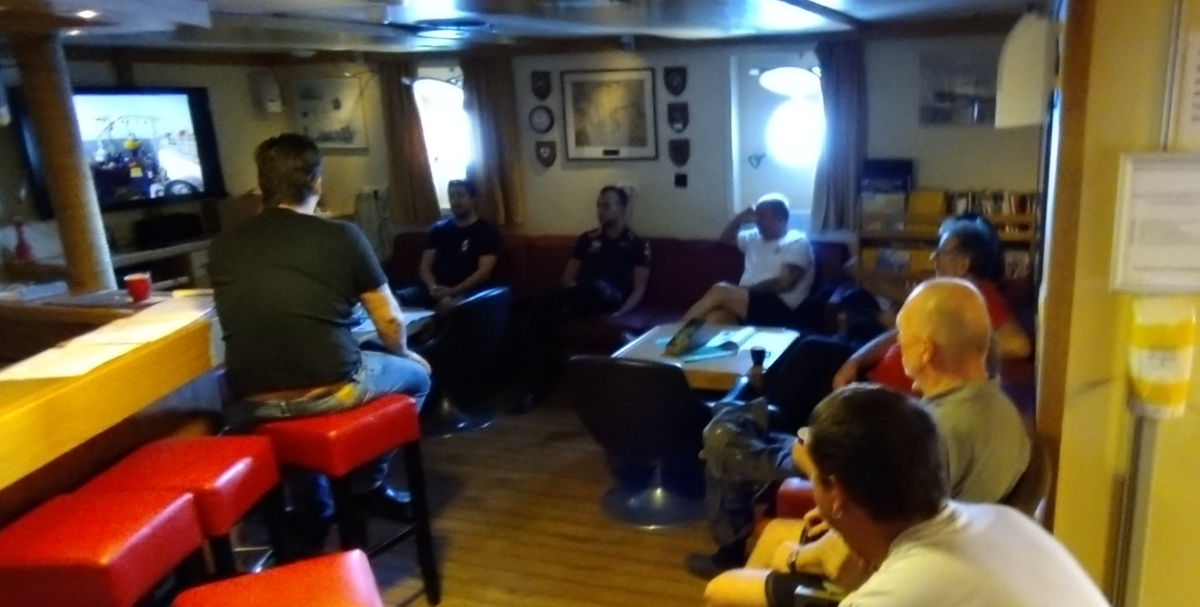
20 January: Some tools
RV Pelagia's aft is full of special dedicated tools with which the dust-collecting instruments shall be handled. The flat blue construction on deck is a custom-made standard on which the dust-collecting buoys can be placed securely. On the left is a special blue winch with a white reel to spool cables on. The orange round thing in the middle (looks like a big orange M&M) is a float with a buoyancy of 500kg. Behind it is the orange-and-blue double-barrel winch with which all the cables can be spooled and on the right, at starboard side, is the yellow buoy which shall be labeled Laura.
As you can see on the picture, we have entered nice-weather area; the seawater has a temperature of about 19°C and the air temperature is about the same. This is what we call: "technical weather". #lovemyjob
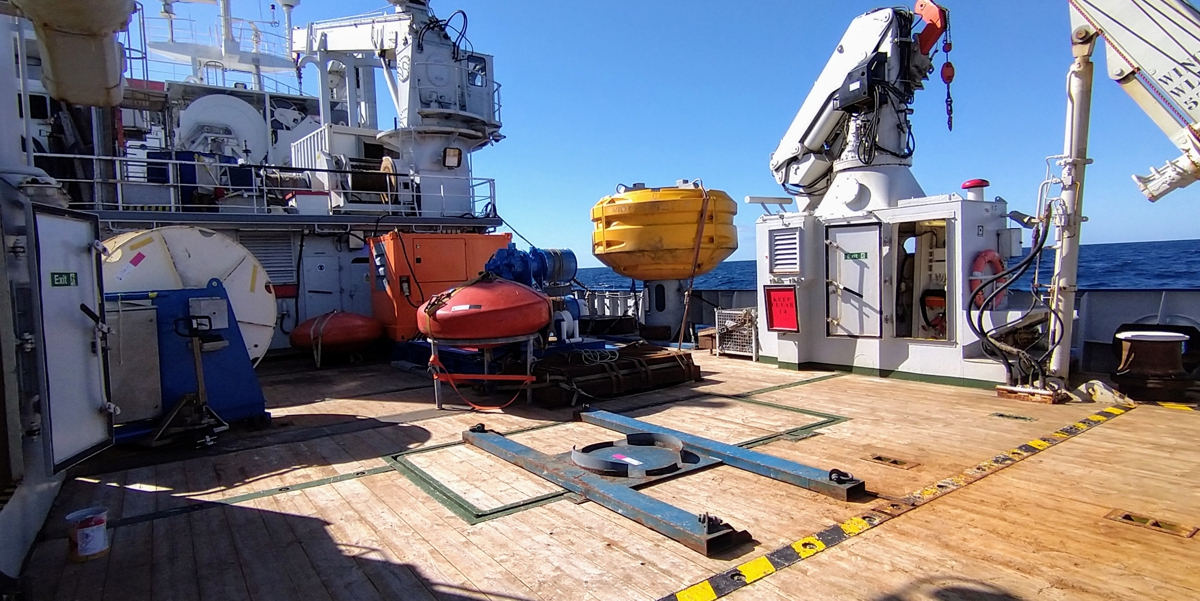
19 January: Fire drill
Just as we practiced an abandon-ship manoeuver on the first day, now it is time to practice what to do in case of fire onboard the ship. For the ship's crew this means that they have to respond as fast as possible, get their gear on, find the fire and extuingish it. For the scientific crew it basically means to prepare for the worst (abandon ship) by going to the muster station in front of the bridge with life vest and life suit.
Fortunately, the fake fire in the paint store was extuinguished really fast, the poor AB in there was brought to safety and Master Len could tell Chef Alex to send us all back to work. We hope to never have to put this exercise into practice!
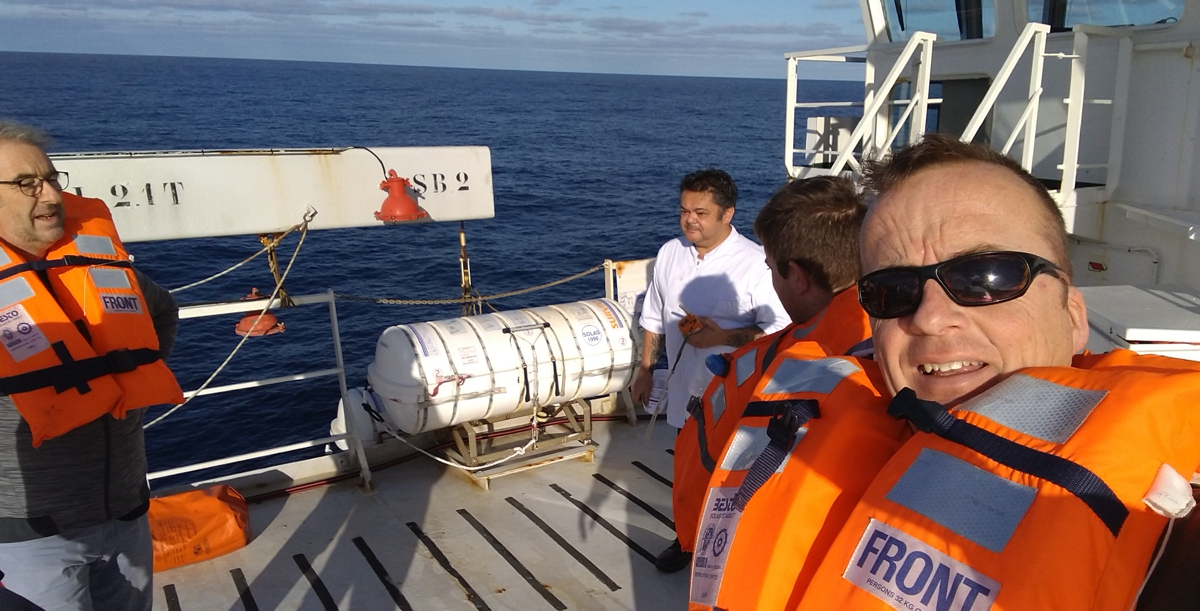
18 January: Getting ready to collect some dust
On the highest deck above the bridge we have installed two high-volume dust collectors (the blue mailboxes on the photo). They basically consist of a vacuum-cleaner engine --hence their nicknames-- which pump air through a A4-sized filter at ~1000 liters air / minute. Depending on how much dust is in the air, these filters are full within hours to days. We obviously want as much dust as we can get but also from as small an area as we can. Dust-model predictions tell us that from the latitude of the Canary Islands there will be plenty of dust again, and we will reach this area in a few days from now.
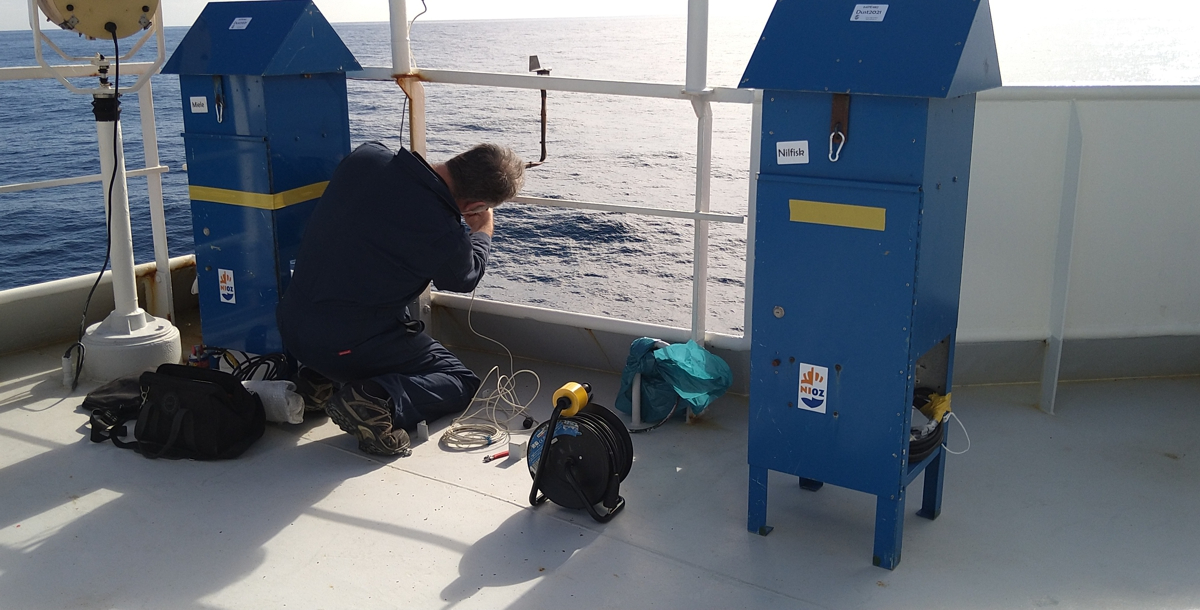
To prevent pollution from e.g. the ship's chimney, we have installed a wind vane (black thingy, indicated by orange arrow) which makes the sampler shut down as soon as the wind comes from the wrong direction. In addition, we want to prevent rain from being sucked into the samplers and therefore we have also connected a rain sensor (transparent thingy, indicated by blue arrow) that makes the samplers switch off at the first rain drops. We are also VERY interested in the amounts of dust that are washed out of the atmosphere with rain and for this reason we will set up various additional samplers; basically: boxes.
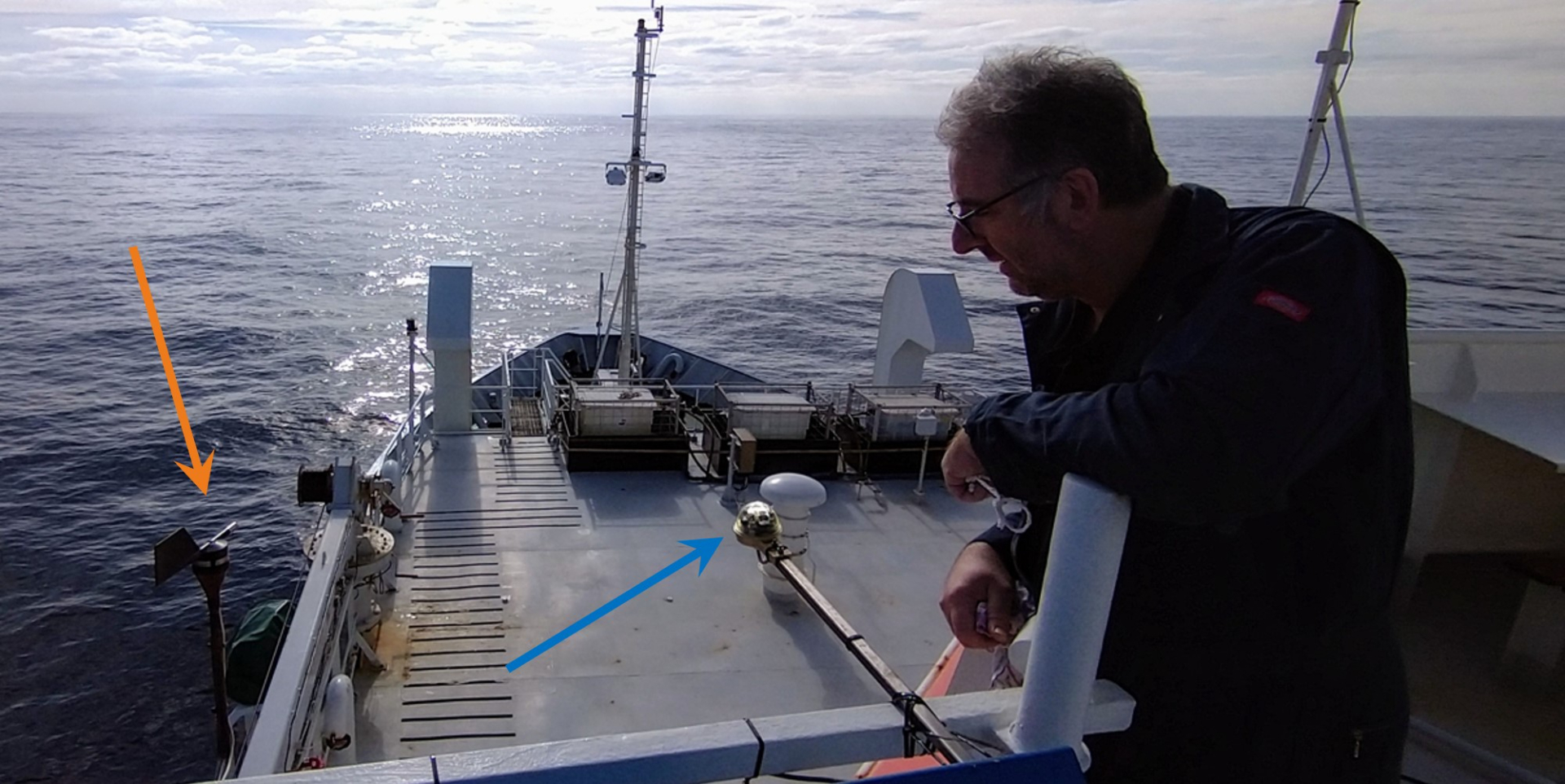
17 January: Excellent timing
Thanks to advanced meteorological prediction models, we can see what the weather and sea-state will be in the area our transit leads us through. We could see that thanks to a low-pressure cell over the Atlantic Ocean, the waves in the Bay of Biscay were going to increase in size. Below you can see an animation of the sea state (from the website windy.com) with warmer colours indicating higher waves. A scale bar is shown in the lower right corner, the date in the lower left corner. The position of the Pelagia indicates our position on the map: we fortunately made it out just in time!
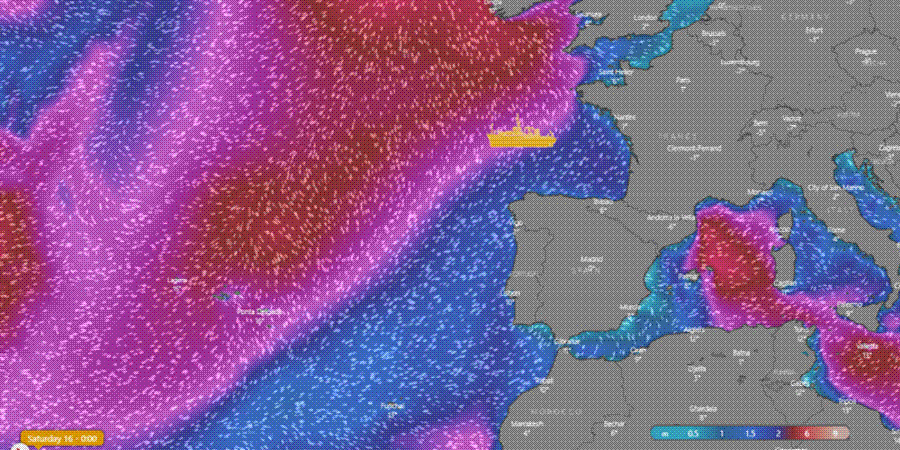
16 January: All calm, little traffic
Thanks to the absence of wind, the sea is nice and calm. Now and then the sun pinches through the thick clouds, sometimes putting other ships nicely in the spotlight. If we can keep the present speed of ~10 knots, we will arrive at our first station (buoy Carmen, off Cape Blanc, Mauritania) in a week from now.
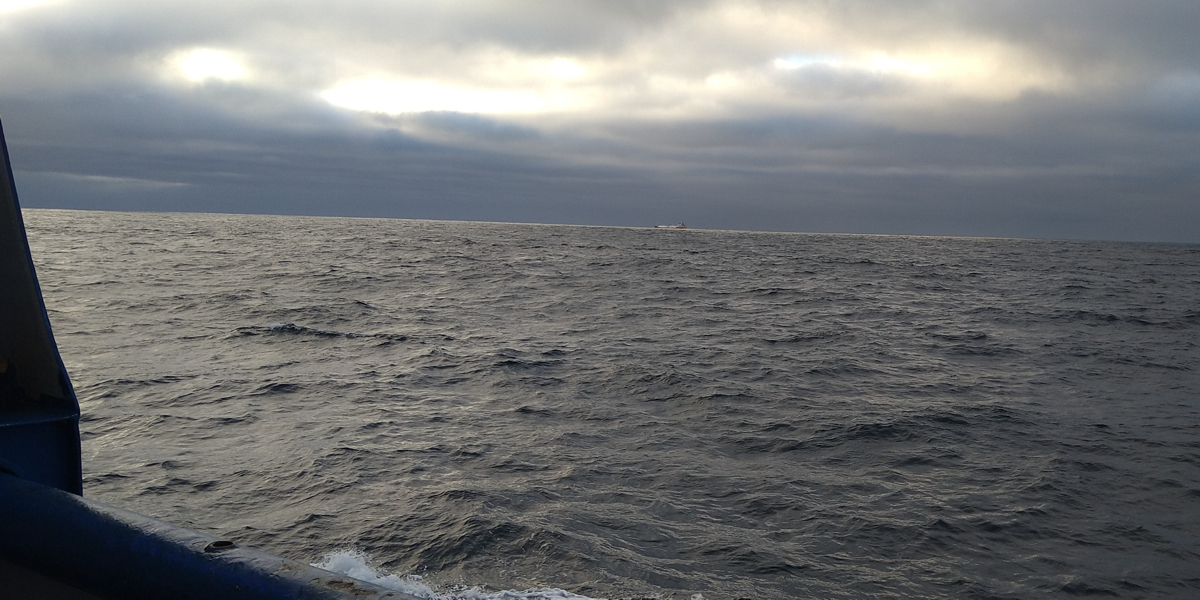
15 January: Sunset #1
Anyone who has been to sea knows that sunsets are usually quite spectacular. We are very aware that the skies turn red because of aerosols that are suspended in the atmosphere: dust!
...yet another reason to be enthusiastic about our work....
#welstoffignietsaai
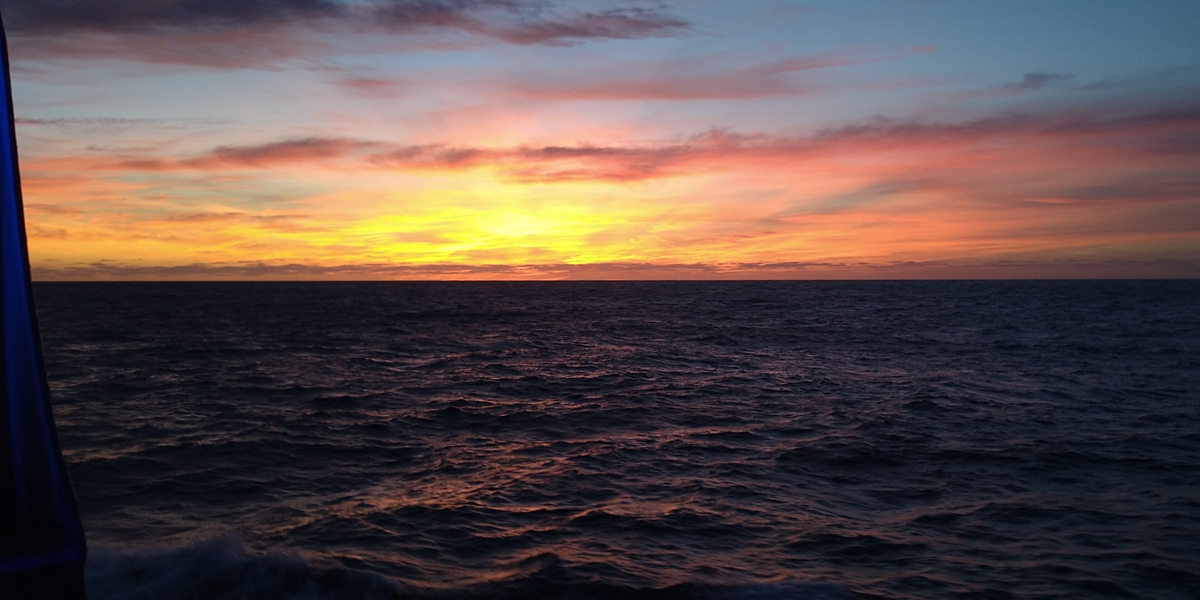
15 January: into the Bay of Biscay
We have left the English Channel and are entering the Bay of Biscay under exceptionally calm conditions. The forecast looks really good too, so that we are optimistic to make good speed from now on. The next low-pressure cell is approaching across the Atlantic but with a bit of luck, we can just escape the increasing swell.
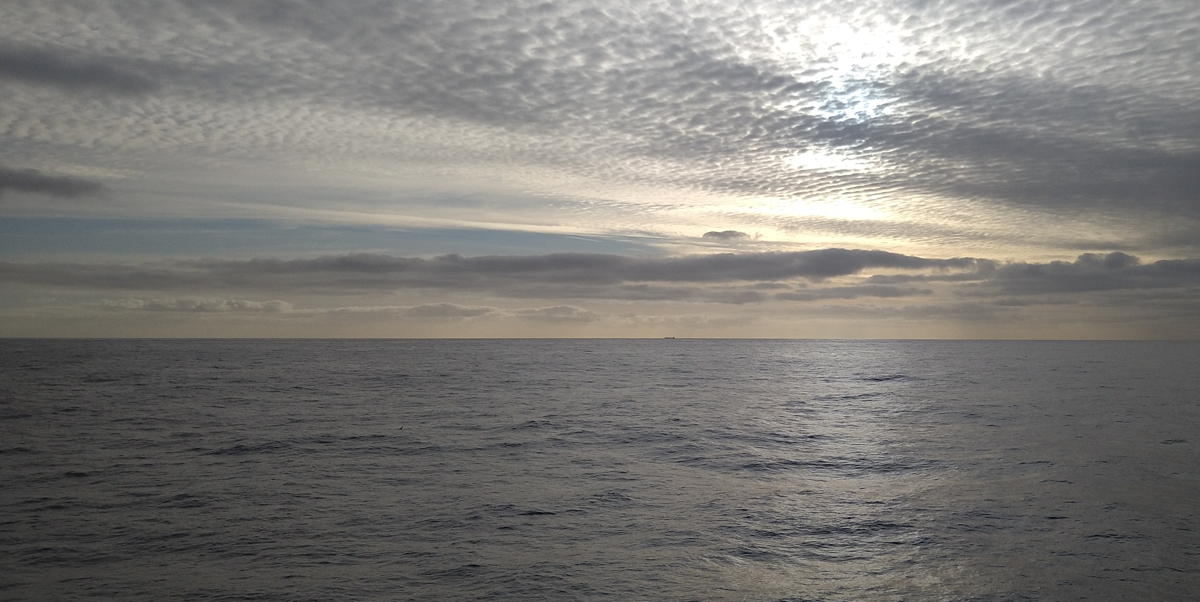
14 January: Happy birthday Alex!
Very important crew members spend most of their time in the pantry: chef Alex and steward Alex take very good care of us! And since it is Alex' birthday today, Alex had prepared a very nice cake for him (and for us!). Happy birthday Alex!
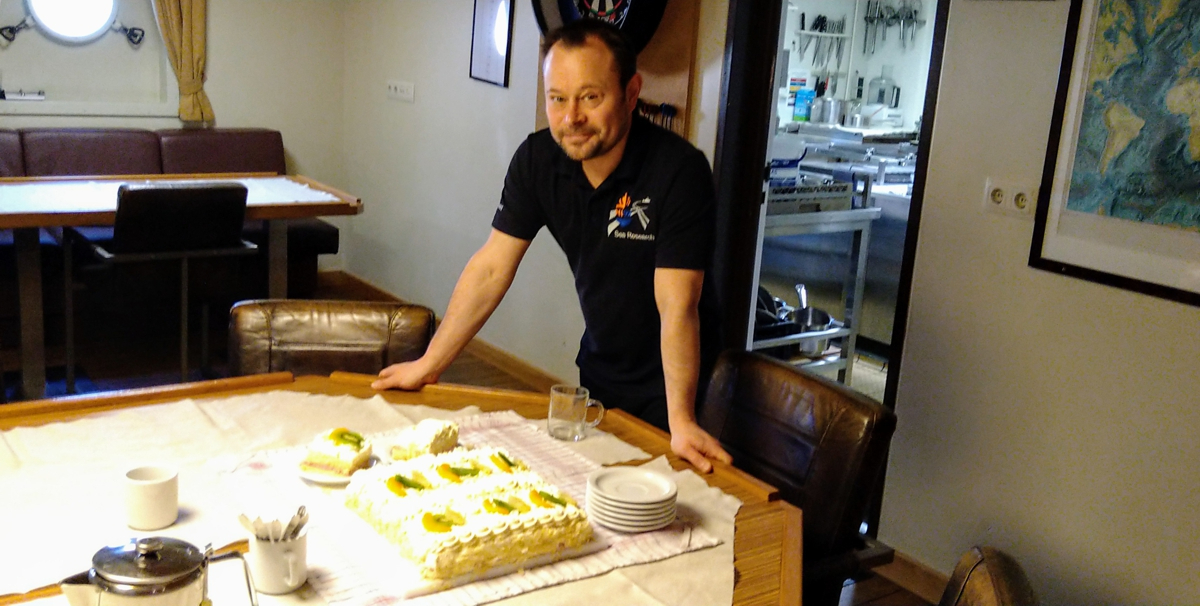
14 January: trying to escape the English Channel
One can tell that the English Channel is a highway for naval transport; all kinds of vessels all around! Wind and tide are working against us at the moment, so we cannot make the speed we would want. Fortunately, the tide will turn soon and work in our favour again so we can set course towards the Bay of Biscay.
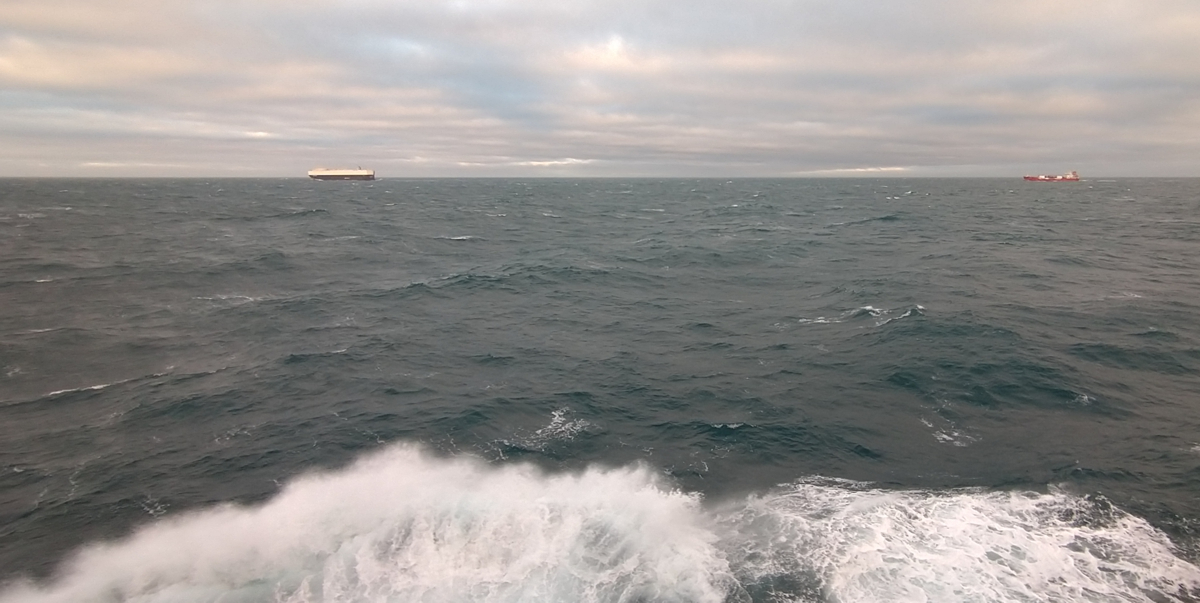
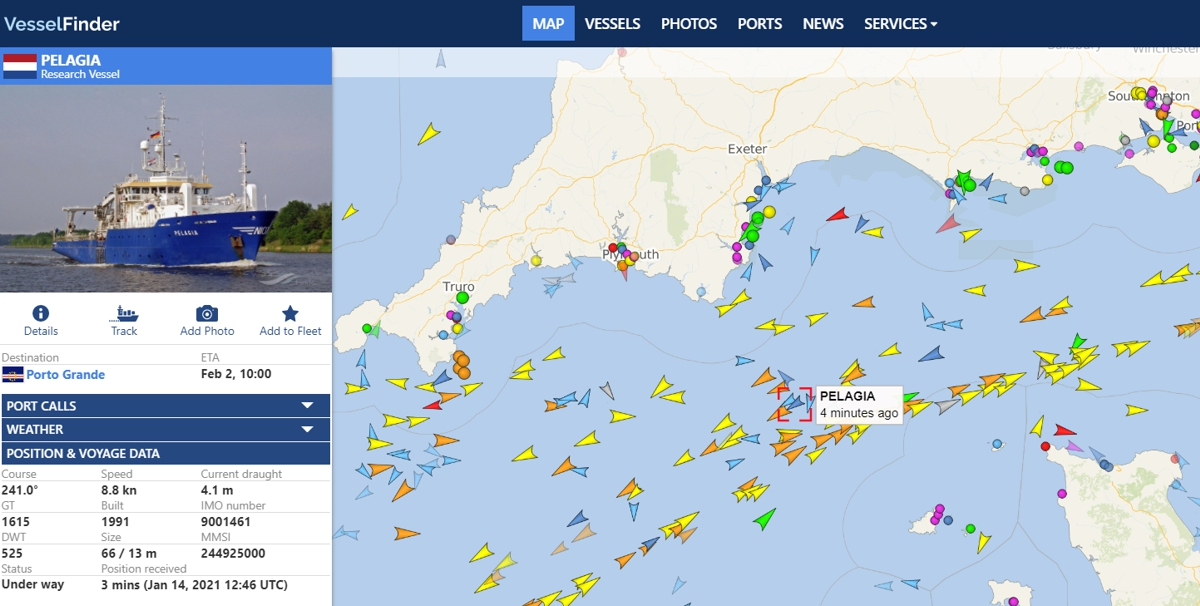
13 January: The white cliffs of Dover
After a bumpy start yesterday we changed to a more favourable course during the night and very calm conditions in the morning of Wednesday 13 January. At sunrise we sailed through The Channel with a nice view on the white cliffs of Dover on starboard and Cap Gris Nez under a rising sun on portside. If you look closely, you can just see the white cliffs in the photo.
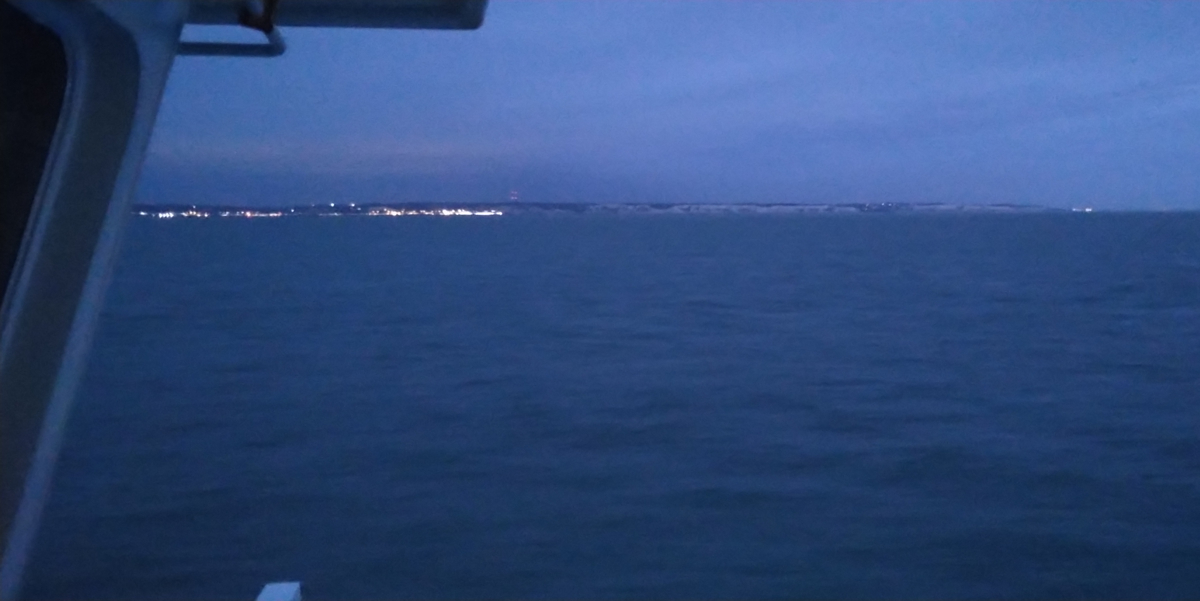
12 January: Dutch seascape
The fresh wind sweeps up the waves and the sun and clouds provide a typical Dutch seascape. We realise how lucky we are. #lovemyjob
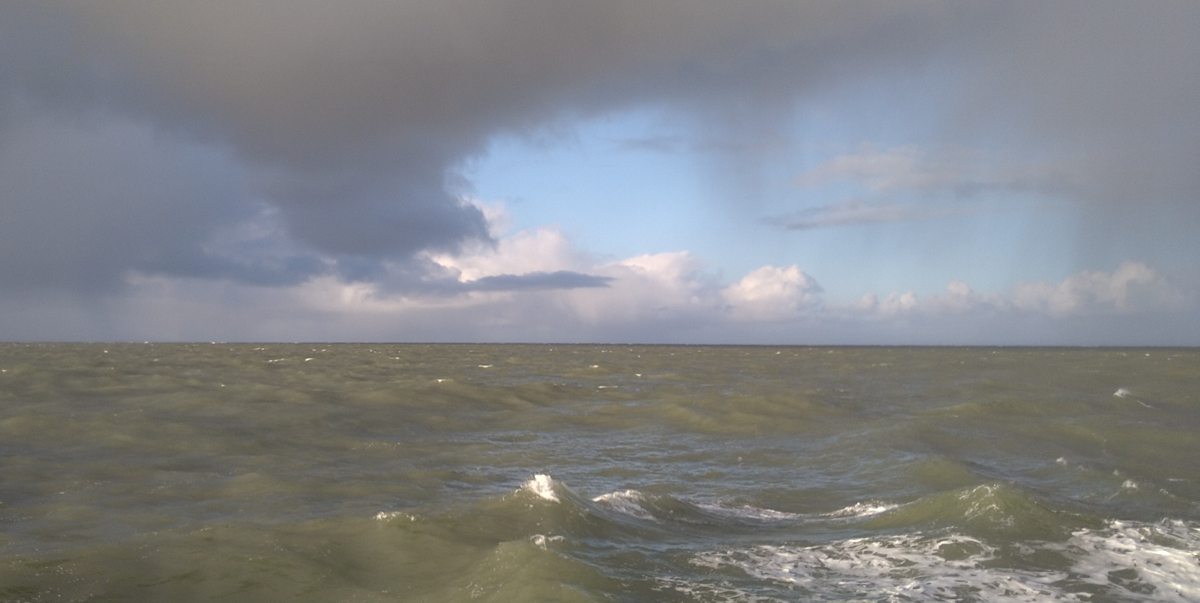
12 January: Leaving Texel
At 14.00 sharp, Master Len Bliemer blows the ship's horn to say goodbye to our family, friends and colleagues. The rainbow provides a nice touch to the start of our trip.

....this is what our family saw: a happy crew onboard RV Pelagia (image by Meta v/d Wal)
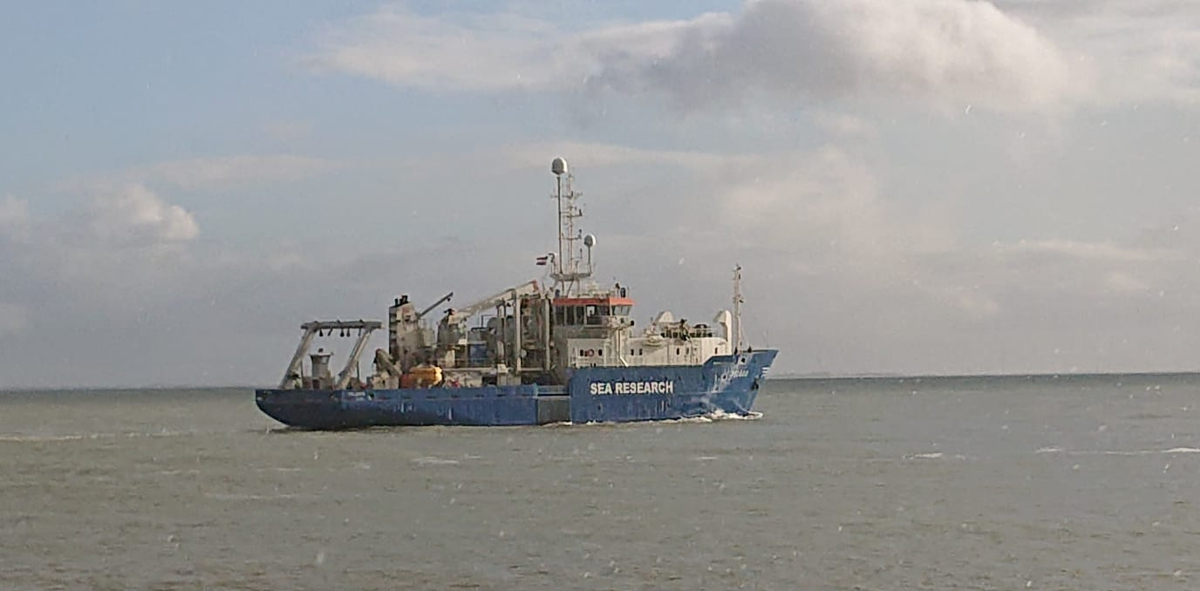
12 January: Our home for the next month
This picture was taken shortly before leaving the NIOZ harbour on Texel. We are very happy that we will be able to continue our work at sea despite all the restrictions. Looking forward to a successful month at sea!
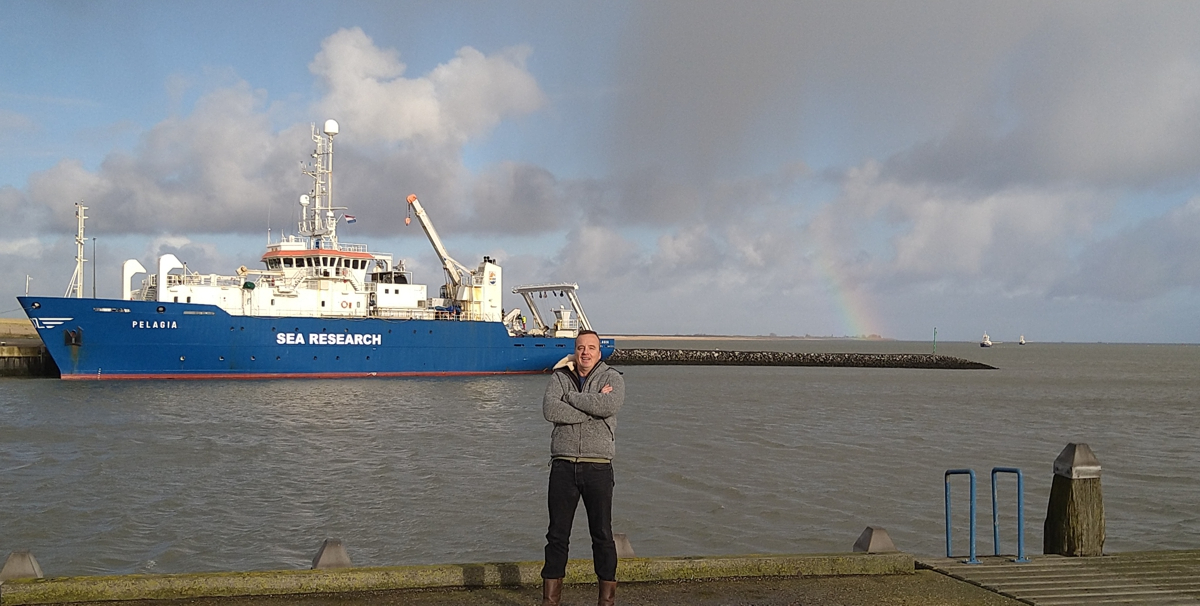
9 January: Buoy on land
Here you see one of the spare buoys, waiting on the quay of the NIOZ harbour to be hoisted on board the RV Pelagia. Conditions at sea are very hostile towards any metal and therefore, we had to pimp the metal parts of the buoy by galvanizing them. Before we will baptize this buoy Laura, we will pimp the upper part of the buoy as well and paint her name back on.
7 January: Loading the ship
Under a grey sky the ship is being loaded with all the material we need to service all the dust-collecting instruments. Here you see how a 3,500kg weight, which will serve as an anchor for one of the buoys, is being hoisted by the ship's crew; it is so heavy that it makes the ship tilt!
5 January: RV Pelagia in the NIOZ harbour at sunrise
We often fondly refer to RV Pelagia as "the blue boat" and with the newly installed lights, she contrasts nicely with the red colours caused by the sun rising over the Wadden Sea.
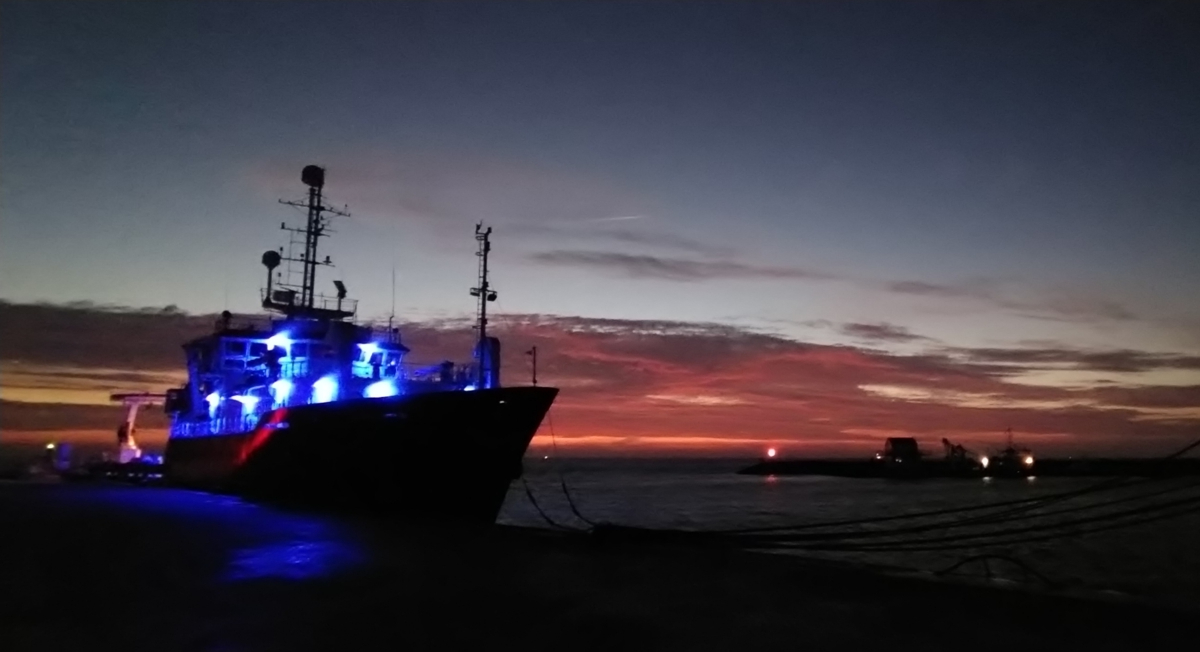
22 December: no shops at sea
For all the measurements we intend to do at sea, we have to bring all the equipment and consumables. This is why preparations are already in full swing; let's hope we did not forget something!
